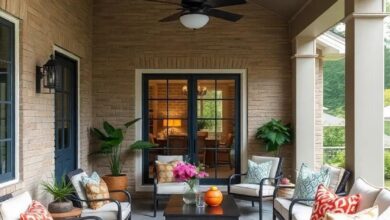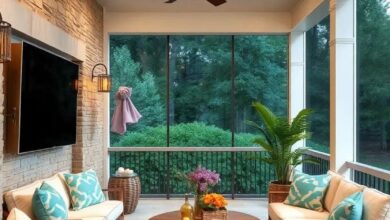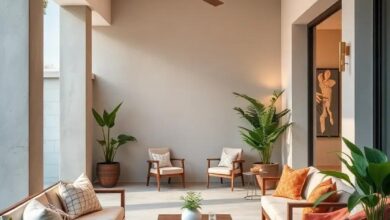Transform Your Patio: Creative Wall Art and Murals for Outdoor Style
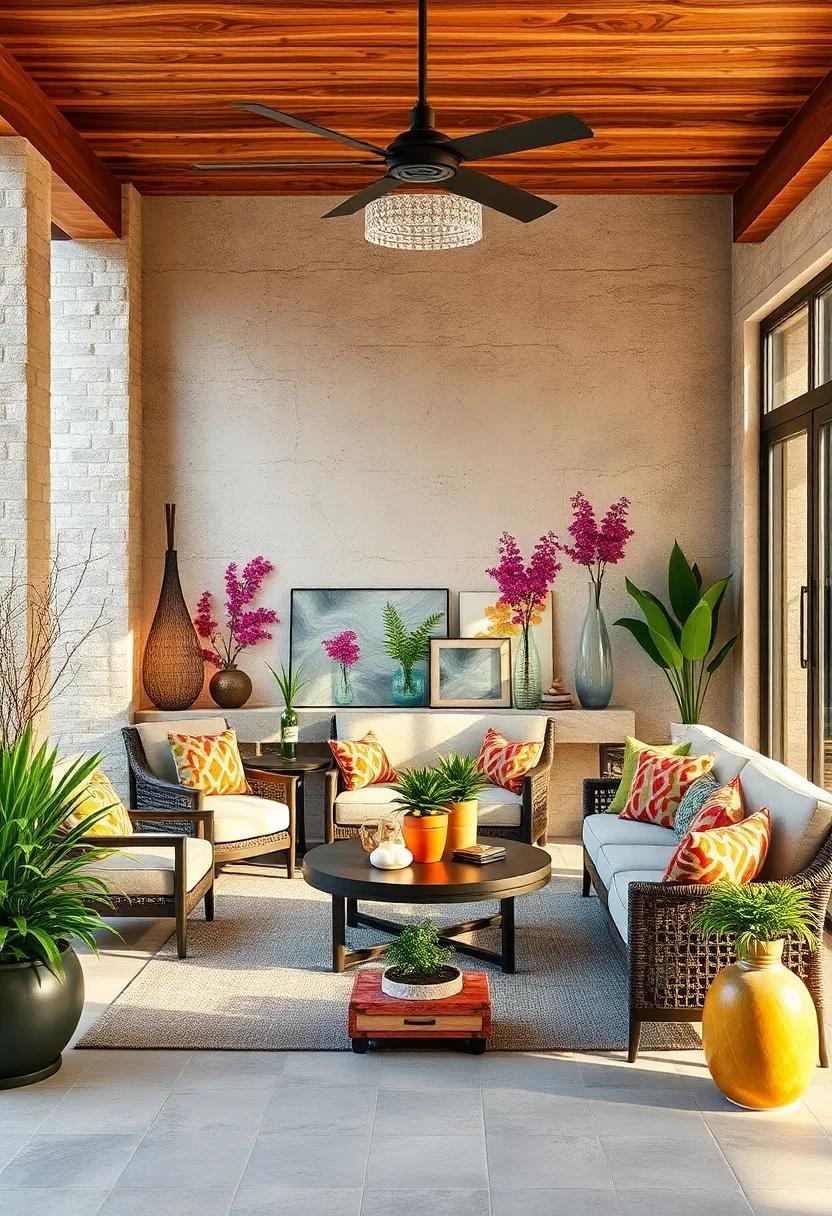
Your patio is more than just an outdoor space-it’s an extension of your home’s personality and a canvas waiting to be brought to life. Transforming this area with creative wall art and murals offers a unique opportunity to blend nature’s beauty with artistic expression. Whether you favor bold, vibrant designs or subtle, textured patterns, the right mural can redefine your patio’s atmosphere, making it a welcoming retreat for relaxation and entertaining. In this article, we’ll explore inspiring ideas and practical tips to help you elevate your outdoor style through striking wall art that turns ordinary walls into extraordinary statements.
Transform Your Patio Into a Vibrant Outdoor Gallery Filled With Bold Wall Murals and Colorful Art
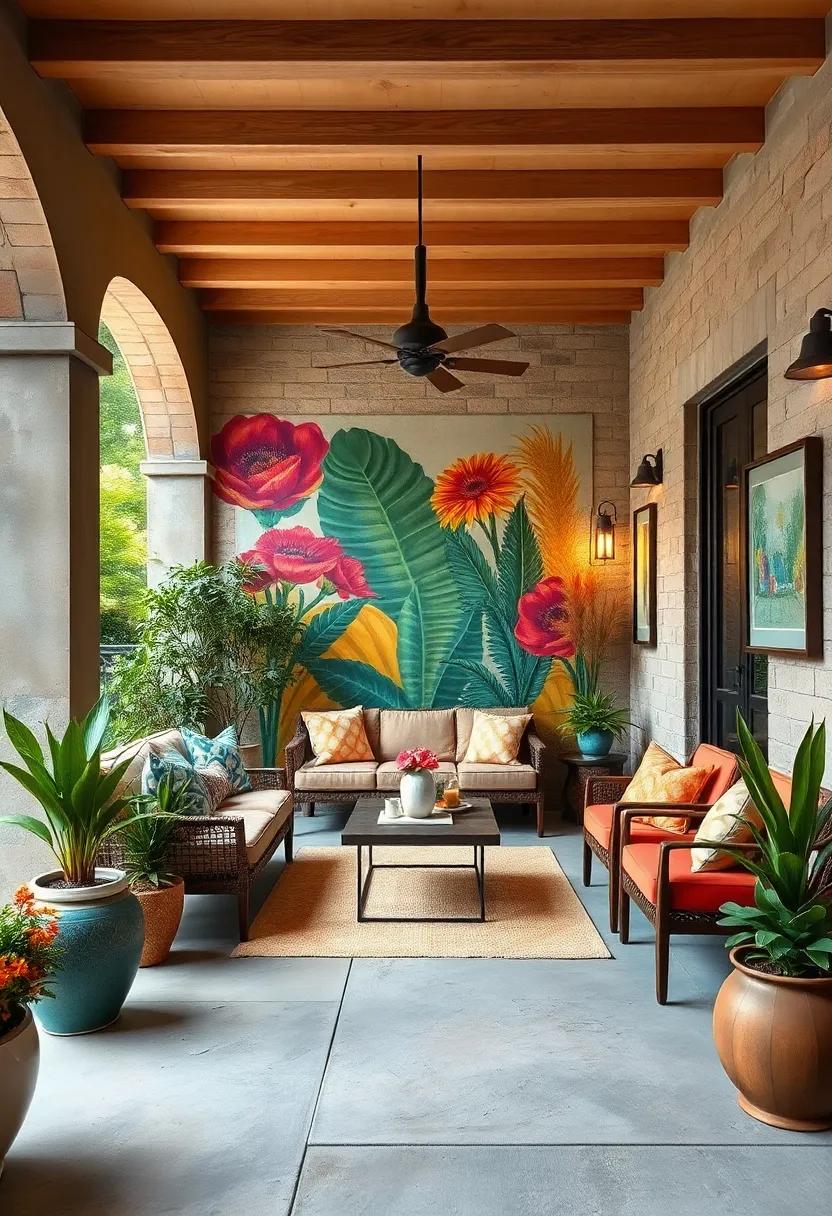
Inject life and personality into your outdoor space by choosing bold, expressive murals that reflect your taste and inspire creativity. Whether you opt for large-scale abstract designs or nature-inspired motifs, these vivid artworks transform ordinary patio walls into dynamic canvases that captivate attention. Incorporate vibrant colors and playful patterns to draw the eye, making your patio an inviting haven for relaxation and social gatherings. Consider materials and paints specifically designed for outdoor durability to ensure your masterpiece withstands weather changes and retains its brilliance year-round.
To create a cohesive yet eclectic vibe, mix and match various types of wall art such as:
- Geometric murals that add structure and modern flair
- Floral and botanical paintings to bring nature directly onto your walls
- Textured and mixed-media pieces for tactile interest and dimension
- Custom graffiti art that exudes urban charm and personal storytelling
| Art Style | Color Palette | Recommended Materials |
|---|---|---|
| Abstract | Bold reds, blues, yellows | Weather-resistant acrylic paint |
| Botanical | Greens, soft pinks, earthy browns | UV-protected outdoor mural paint |
| Urban Graffiti | Bright neons, black, white | Spray paint with anti-fade coating |
| Mixed Media | Varied – layered earth tones & metallics | Composite materials + sealants |
Natural Elements Imagined On Outdoor Walls With Botanical Patterns and Rustic Earth Tone Palettes
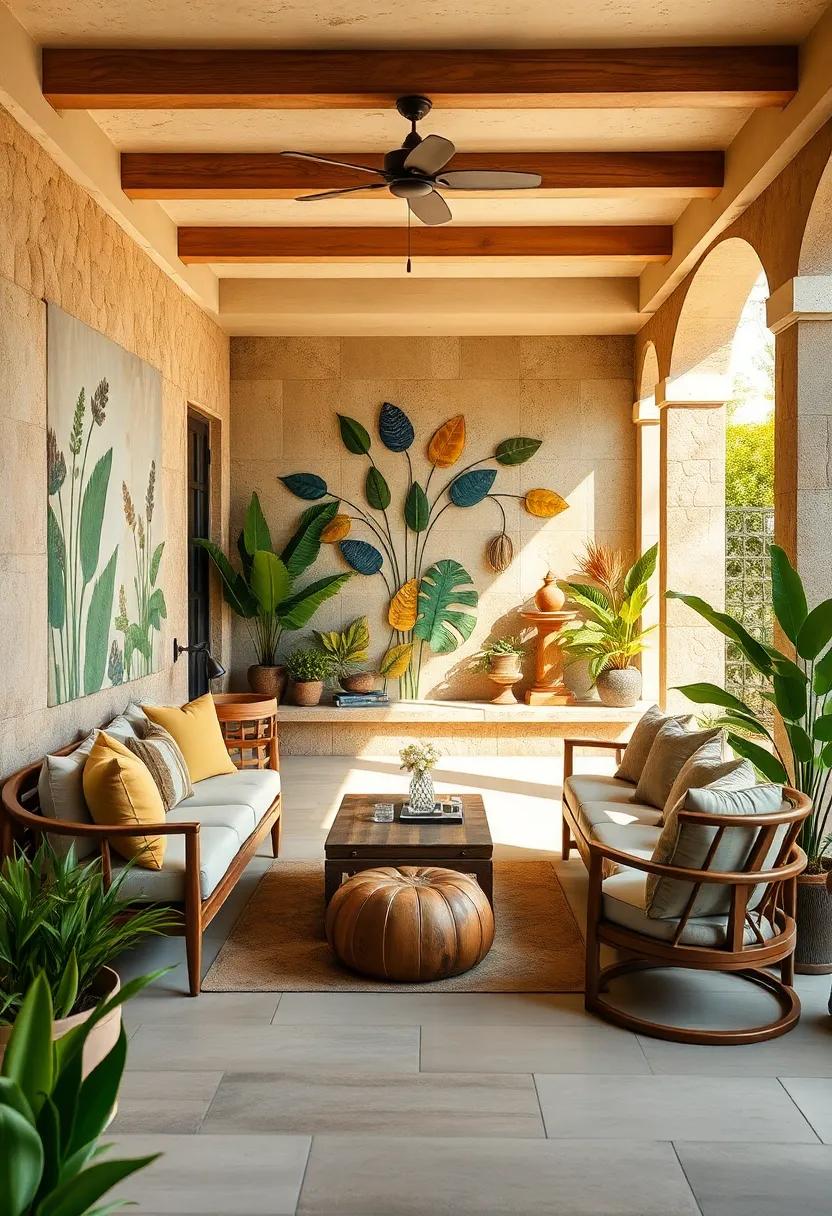
Embracing the outdoors becomes an immersive experience when the walls around your patio artfully mimic the serenity of nature. Imagine delicate vines weaving across a textured surface, leaves painted with subtle gradients of sage and olive, and hints of raw bark patterns that bring a tactile warmth to any outdoor setting. These botanical-inspired murals do more than decorate-they invite life and tranquility into your space, curating a natural haven where every glance connects you with the earth’s quiet beauty.
The choice of a rustic earth tone palette deepens this connection, fostering a grounded atmosphere that complements any style of patio furniture or greenery. Colors like terracotta, warm taupe, moss green, and soft ochre work harmoniously to create a soothing backdrop. Consider integrating the following elements to enhance your mural’s effect:
- Layered leaf motifs that play with depth and shadow for a three-dimensional feel.
- Organic textures like stone or wood grain painted subtly into the background.
- Muted contrasts to keep the focus natural yet visually engaging.
| Element | Color Palette | Effect |
|---|---|---|
| Leaves & Vines | Sage Green, Olive | Adds movement and life |
| Rustic Earth Tones | Terracotta, Taupe, Ochre | Creates warmth and grounding |
| Textured Backgrounds | Stone Grey, Wood Brown | Adds tactile depth and rustic charm |
Geometric Shapes and Abstract Art Combining Modern Lines and Bright Colors for a Contemporary Patio Look
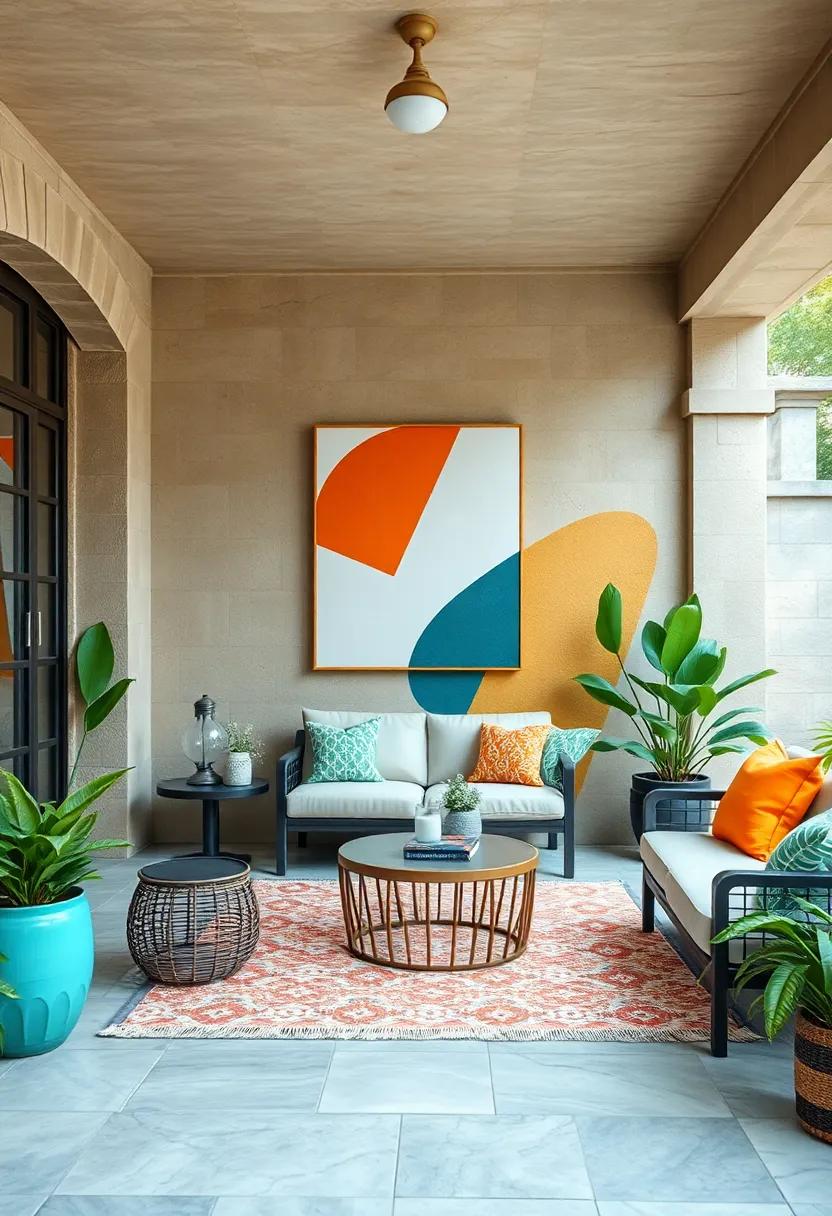
Inject a fresh vibe into your outdoor space by embracing clean, geometric shapes paired with vibrant, abstract designs. Think bold triangles, crisp circles, and dynamic rectangles, all layered with daring splashes of fuchsia, turquoise, and sunny yellow. This approach not only modernizes your patio walls but also creates a captivating focal point that draws eyes and sparks conversations. Using contemporary patterns with sharp lines and bright hues transforms any bland surface into an artful extension of your personality and style.
To achieve the perfect balance of modernity and vibrancy, consider incorporating these elements in your mural or wall art:
- Repetitive geometric patterns: Create rhythm and flow using tessellations or overlapping shapes.
- High-contrast color schemes: Use complementary colors for eye-catching energy.
- Asymmetrical designs: Maintain visual interest by breaking regularity.
- Textured finishes: Add depth with matte and glossy paint combinations.
| Shape | Color Palette | Effect |
|---|---|---|
| Triangles | Cobalt Blue & Coral | Energetic & Bold |
| Circles | Lemon Yellow & Magenta | Playful & Inviting |
| Rectangles | Emerald Green & White | Calm & Modern |
Ocean and Beach Inspired Wall Murals Evoking Coastal Calm and Seaside Breezes on Your Outdoor Space
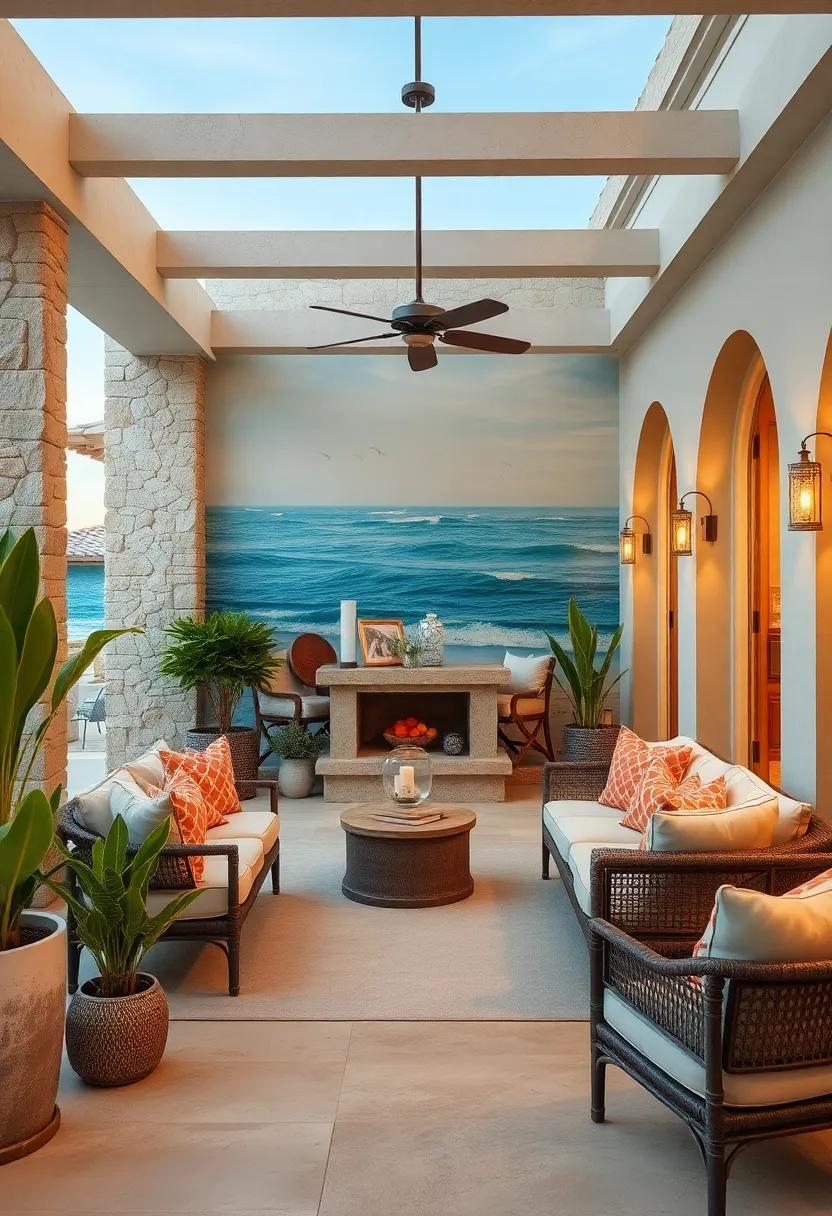
Bring the tranquil essence of the coast right into your backyard with wall murals that capture the soothing rhythm of ocean waves and the gentle sway of seaside palms. Imagine lounging beneath a vast mural depicting a sun-kissed beach scene, where the soft blue hues blend seamlessly with your outdoor cushions and décor. These artistic expressions not only add visual depth to your patio but also immerse you in the calming spirit of the sea, making every outdoor moment feel like a peaceful retreat.
Opt for designs featuring elements like:
- Rolling ocean waves in shimmering aquamarine tones
- Seabirds soaring above sandy dunes
- Sunset horizons glowing in coral and lavender
- Driftwood textures and seashell motifs
These artistic choices not only complement natural patio materials but also invite the fresh, salty breeze of the coast into your everyday space. To guide your selection, refer to the palette below to harmonize mural colors with your outdoor furnishings:
| Mural Element | Color Palette | Suggested Patio Accents |
|---|---|---|
| Ocean Waves | Aquamarine, Teal, White | Navy cushions, white wicker furniture |
| Seabirds & Dunes | Sand, Beige, Sky Blue | Natural wood accents, light blue ceramics |
| Sunset Horizon | Coral, Lavender, Soft Pink | Soft pastel textiles, lantern lighting |
Whimsical Fairytale Scenes Featuring Enchanted Forests and Magical Creatures on Patio Walls
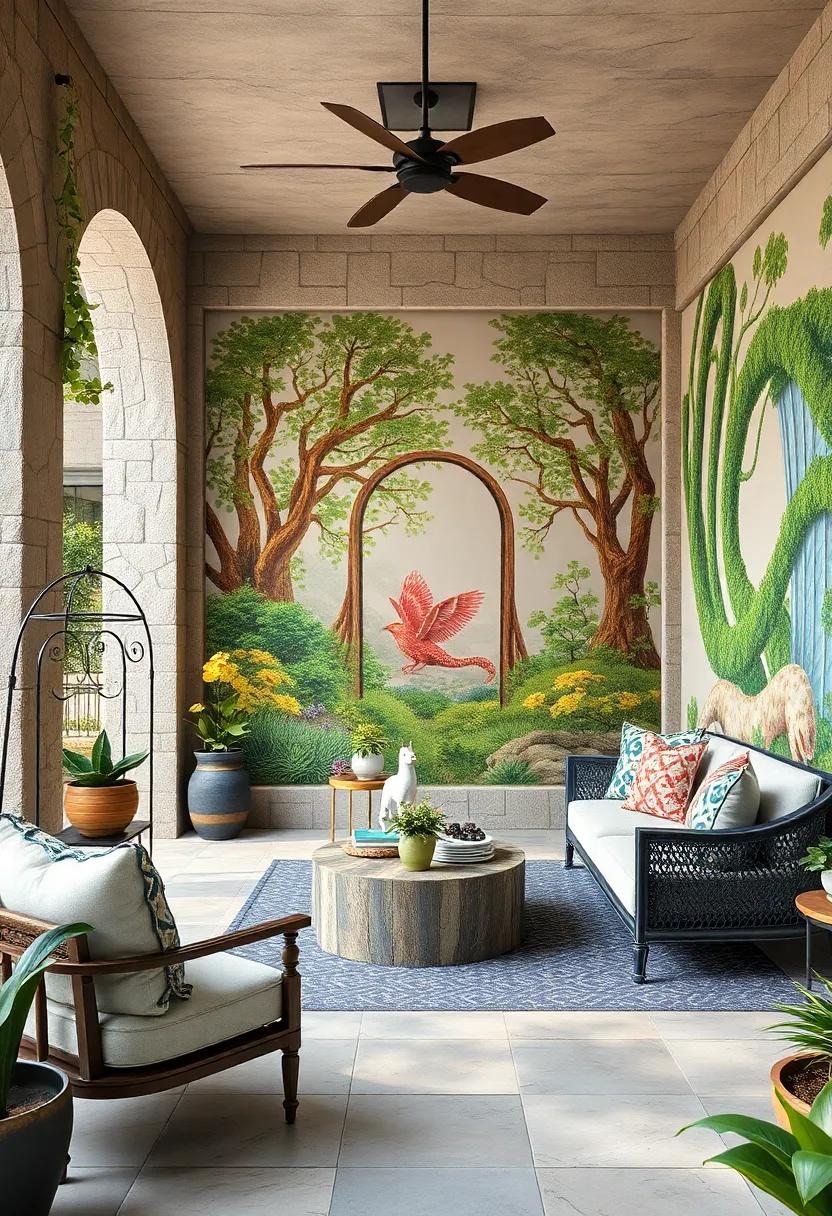
Imaginative patio walls come alive when adorned with scenes from enchanted forests, where towering ancient trees whisper secrets and magical creatures peek through lush foliage. Picture ethereal fairies fluttering near blossom-laden branches or gentle unicorns resting in sun-dappled clearings. These mesmerizing visuals invite a sense of wonder to your outdoor space, transforming it into a mystical sanctuary that sparks creativity and daydreams.
Key elements to incorporate for an enchanting effect:
- Soft, glowing lights mimicking fireflies entwined in vines
- Colorful mushrooms and whimsical flowers bursting with life
- Delicate fairy wings shimmering with iridescent hues
- Mystical animals like owls with wise eyes or playful woodland sprites
- Subtle fog effects painted around tree trunks to enhance mystery
Urban Street Art Style With Graffiti Accents Adding Edgy Energy and Vibrant Color to Outdoor Areas
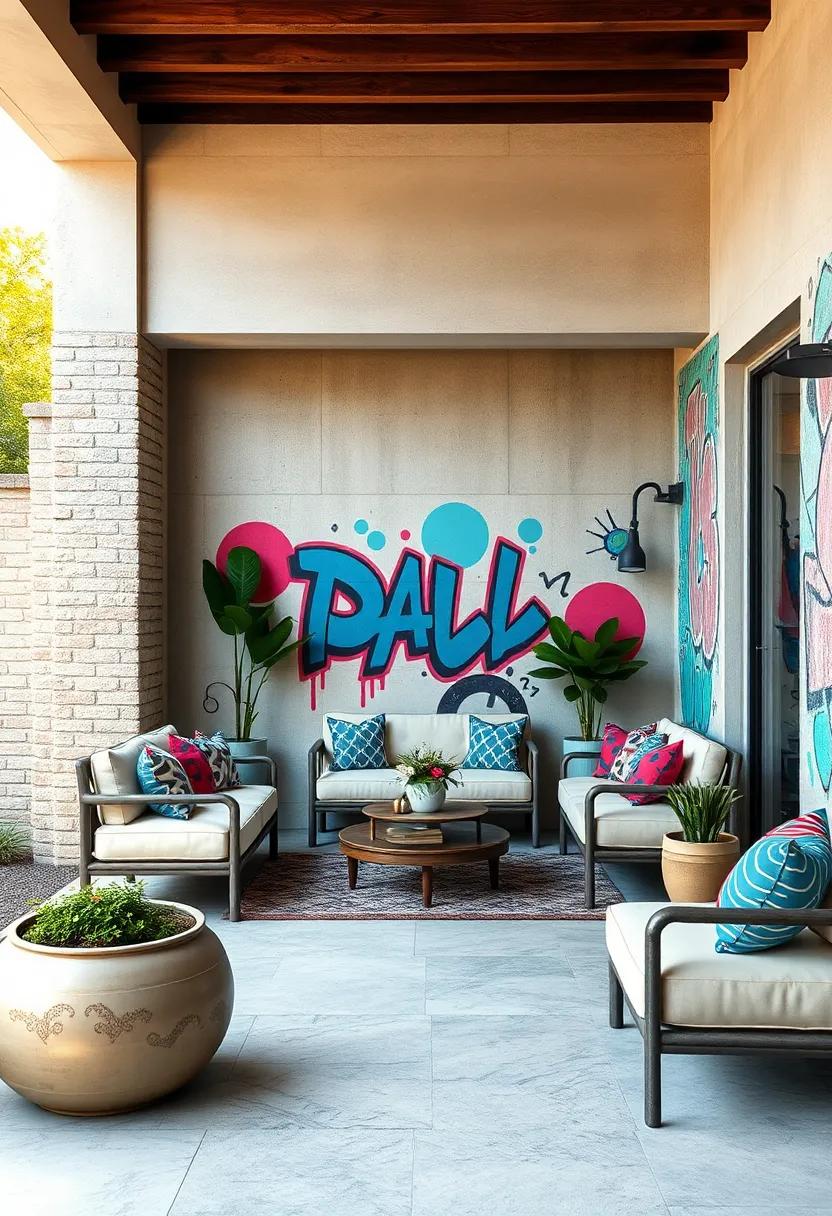
Injecting an urban edge into your outdoor spaces can instantly elevate their character. Infuse walls with bold graffiti accents that bring kinetic energy and vivid color palettes to otherwise plain surfaces. Think splashes of neon, layered stencil motifs, and abstract lettering that interact with natural light throughout the day. Utilizing weather-resistant spray paints and sealants ensures your art remains crisp and vibrant regardless of season or exposure. This style is perfect for homeowners seeking a dynamic backdrop that fuses modern street culture with personal expression.
To make the most striking impact, consider combining various elements like:
- Bold color contrasts: Intense reds, electric blues, and sunny yellows against neutral brick or concrete
- Textural variety: Smooth wall sections paired with rough brick surfaces for layered depth
- Graphic symbols and urban icons: From stylized tags to abstract shapes reminiscent of cityscapes
Experimenting with these accents not only enlivens your patio but also creates an immersive environment that communicates creativity and urban spirit. Consider integrating matchstick or LED lighting to enhance the mural’s presence during twilight hours, amplifying both the visual impact and ambiance.
Vintage Travel Posters and Retro Murals Bringing Nostalgia and Classic Charm to Your Patio Decor
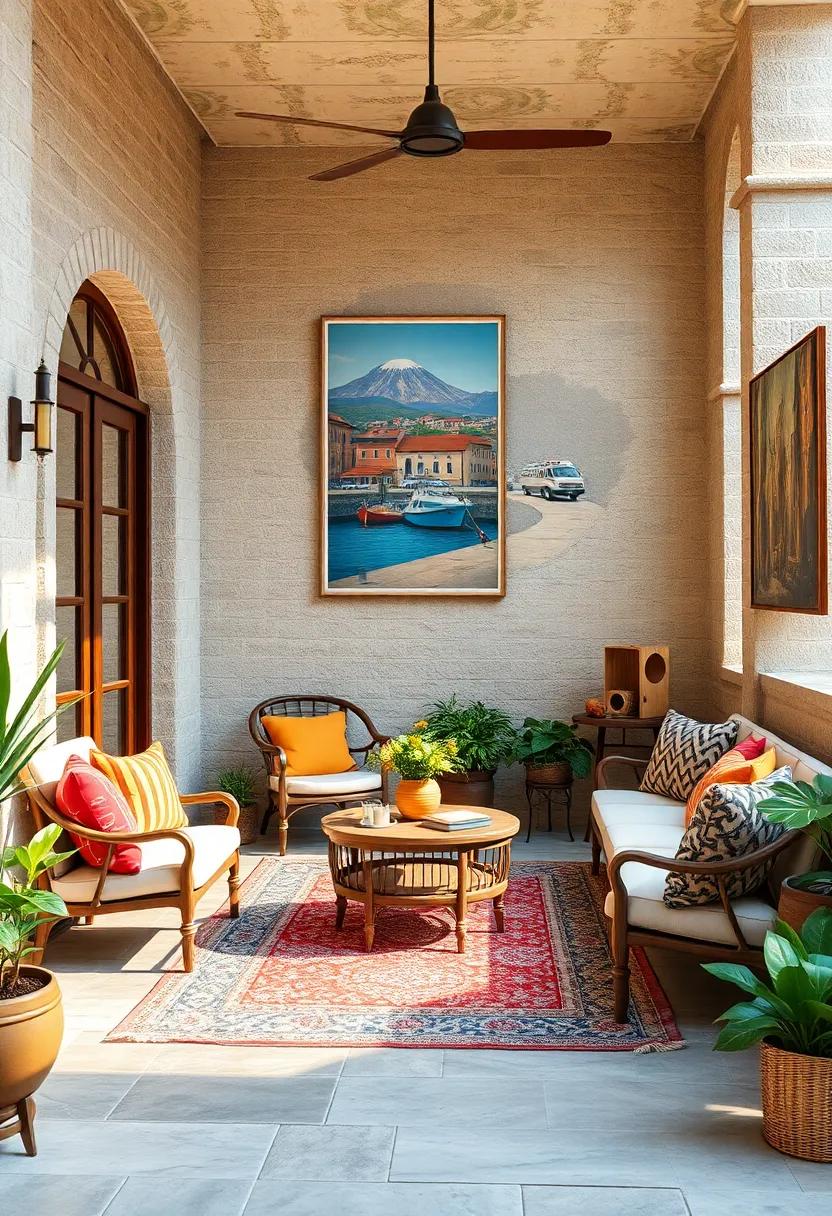
Evoke the golden era of exploration with vintage travel posters that seamlessly blend nostalgia and artistic flair. These posters, often characterized by bold typography and dreamy landscapes, invite you to reimagine your patio as an open-air gallery of timeless journeys. Whether you’re drawn to the exotic allure of 1920s tropical escapes or the charming simplicity of classic European destinations, these retro prints add layers of history and wanderlust to your outdoor haven. Arrange them in clusters or as a focal point to instantly spark conversations and inspire your guests’ imaginations.
Complement your travel poster collection with expansive retro murals that celebrate the era’s distinctive style-think sun-drenched beaches, vintage cars, and old-world maps. Their vivid colors and sweeping designs breathe life into blank walls, creating immersive environments that feel both relaxed and refined. For an effortless, cohesive look, consider these:
- Muted pastel palettes that echo hand-painted advertisements
- Architectural elements reminiscent of mid-century modern design
- Natural weathering effects to heighten authenticity
Exploring these elements enhances patio décor with a charming blend of nostalgia and sophistication.
| Feature | Vintage Travel Posters | Retro Murals |
|---|---|---|
| Color Palette | Bright, bold, expressive | Soft, muted, natural |
| Size Options | Multiple small to medium prints | Large, wall-filling canvases |
| Installation | Easy to frame and hang | Requires wall prep and professional application |
| Vibe | Energetic, adventurous | Calm, immersive |
Tropical Rainforest Themes With Lush Greenery and Exotic Animals Creating a Jungle Retreat Outdoors
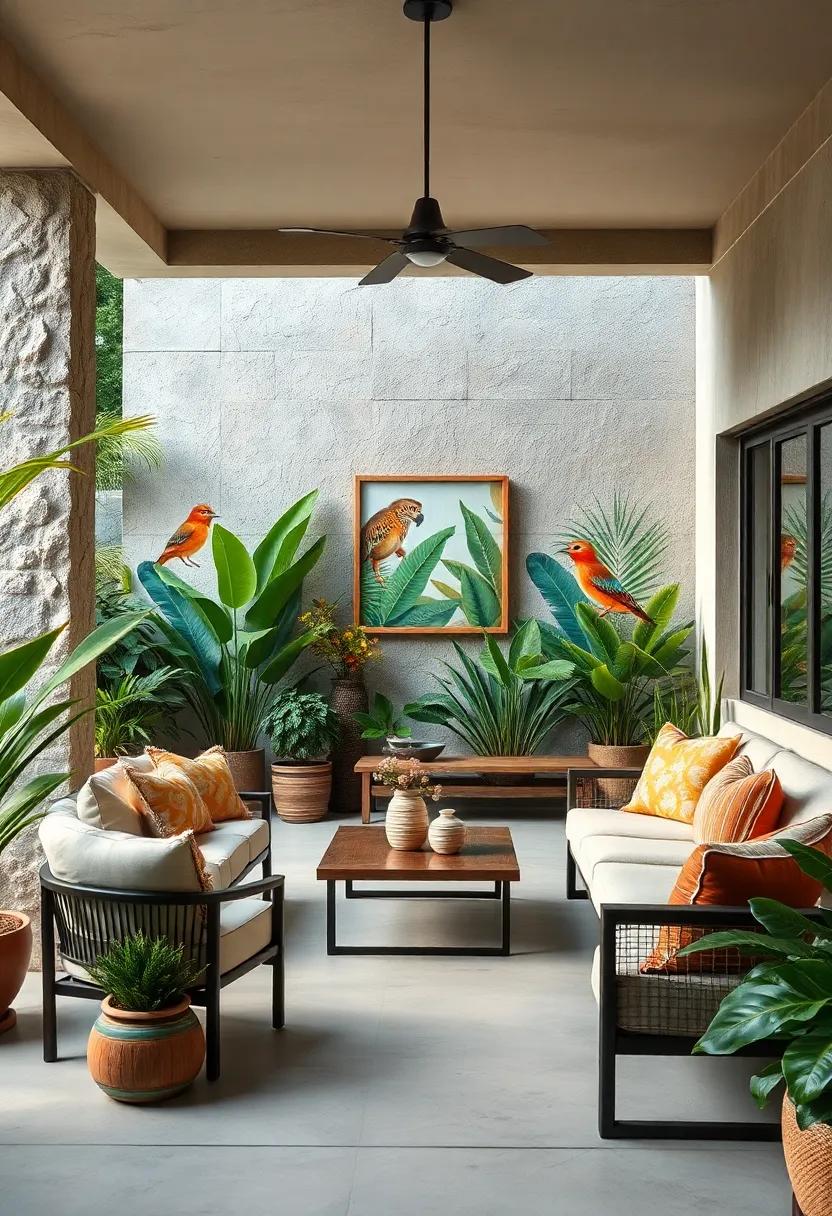
Imagine stepping into a vibrant oasis where every wall bursts with life, echoing the beauty of untamed jungles. By incorporating bold murals featuring towering emerald palms, twisting vines, and delicate orchids, your outdoor space morphs into a lush adventure. Accents of colorful parrots, glistening toucans, and elusive tree frogs bring an exotic allure that transforms simple walls into storytelling canvases. These verdant scenes offer a serene escape, inviting nature’s calm and energy to mingle freely with your patio furniture and garden decor.
To enhance the immersive jungle retreat feeling, consider layering elements alongside your wall art. A curated selection of statement planters, woven hammocks, and rustic wooden accents work beautifully with vibrant greens and vivid wildlife imagery. Try experimenting with textures and depths using 3D foliage appliqués or hand-painted animal silhouettes. Here’s a quick guide to blend these tropical motifs seamlessly:
- Color Palette: Deep greens, soft ochres, and pops of bright reds and blues
- Animal Motifs: Monkeys, jaguars, butterflies, and parrots for varied focal points
- Materials: Natural wood, rattan, and clay for authentic jungle vibes
- Lighting: Warm string lights or lanterns to mimic dappled sunlight
Mediterranean Mural Concepts Highlighting Sun-Drenched Tiles, Olive Trees, and Terra-Cotta Elements
Imagine stepping into a sunlit haven where each mural element whispers tales of the Mediterranean coast. Walls adorned with vibrant sun-drenched tiles burst forth in warm oranges and blues, invoking the timeless charm of seaside villas. These tiles don’t just decorate-they invite light to dance across the surface, creating an immersive atmosphere of endless summer afternoons. Accentuating this rich palette are graceful olive trees, their silvery-green leaves painted with a delicate hand, swaying gently on your patio walls to evoke serene landscapes that inspire relaxation and connection with nature.
To bring this vision to life, consider integrating terra-cotta textures that ground the scene in tradition and warmth. Whether as subtle accents or bold murals, these earthy tones harmonize beautifully with the mosaic tiles and organic foliage, crafting a holistic aesthetic. Creative mural ideas include:
- Geometric patterns inspired by ancient Mediterranean tile designs
- Layered illustrations combining olive branches with hand-painted pottery motifs
- Terracotta-clad borders that mimic rustic outdoor ovens and fountains
| Element | Color Palette | Design Tip |
|---|---|---|
| Sun-Drenched Tiles | Bright Orange, Cobalt Blue | Use gloss finish to enhance sunlight reflection |
| Olive Trees | Silvery Green, Soft Browns | Sweeping brush strokes to mimic gentle wind movement |
| Terra-Cotta Elements | Warm Earth Tones | Incorporate textured paint for rustic depth |
Minimalist Wall Art Emphasizing Clean Lines, Neutral Shades, and Subtle Texture for Sleek Patio Styling
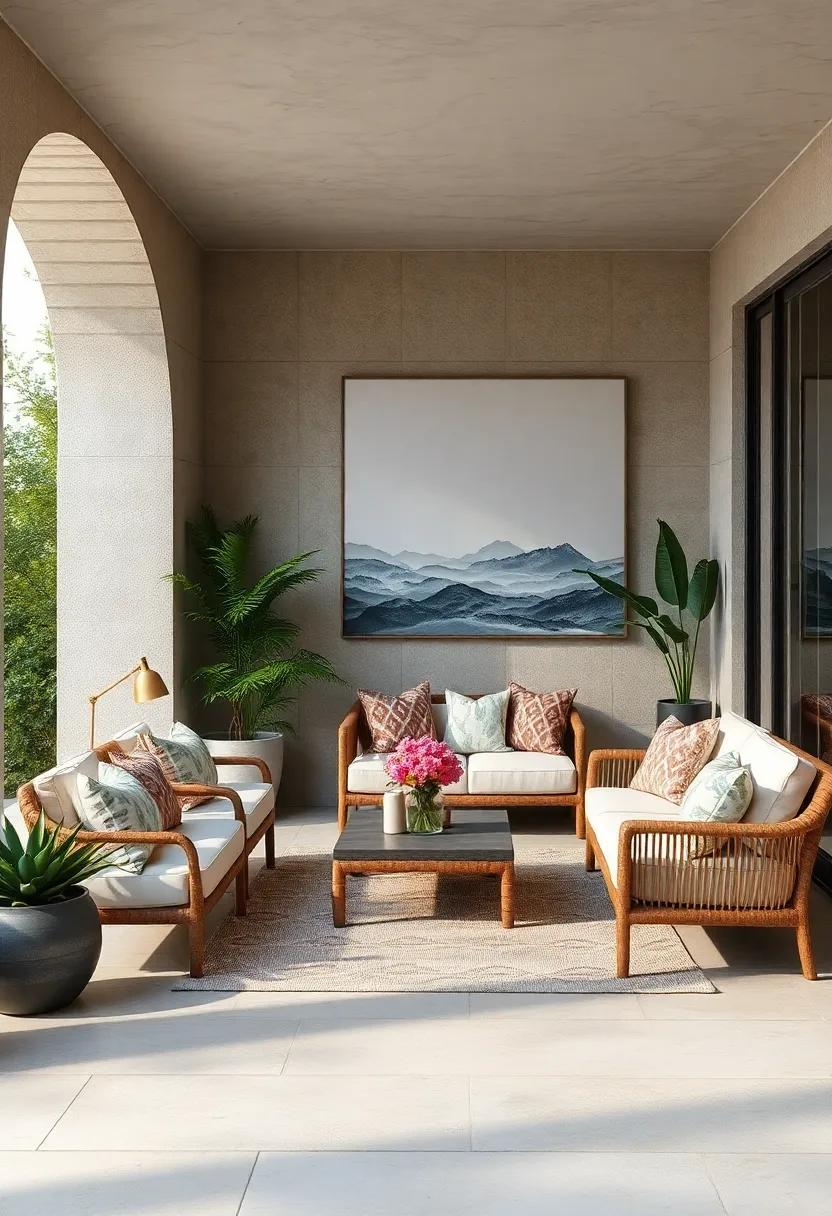
Embracing a refined aesthetic, minimalist wall art for patios champions the beauty of simplicity through clean lines and understated elegance. This approach harnesses the power of neutral tones-think soft beiges, gentle grays, and muted whites-to create a tranquil canvas that lets natural outdoor elements shine. Subtle textures, whether from matte finishes or delicate brushstrokes, add a tactile dimension without overwhelming the space. These choices invite a sleek sophistication that harmonizes seamlessly with modern garden furniture and lush greenery alike, transforming the patio into a serene retreat.
To elevate your outdoor walls with this style, consider incorporating elements such as:
- Geometric metal sculptures in muted metal tones
- Textured ceramic tiles arranged in minimalist patterns
- Natural fiber wall hangings with simple yet captivating weaves
| Material | Texture | Color Palette |
|---|---|---|
| Concrete Panels | Smooth, Matte | Light Gray, Stone |
| Linen Canvas | Soft, Woven | Off-white, Cream |
| Brushed Aluminum | Subtle Grain | Silver, Pewter |
By focusing on simplicity and refined textures, your patio’s walls become a statement of calm productivity and timeless design-ideal for anyone seeking a stylish outdoor sanctuary.
Sunset and Sunrise Skylines Captured in Warm Gradients Expressing Tranquil Outdoor Atmospheres
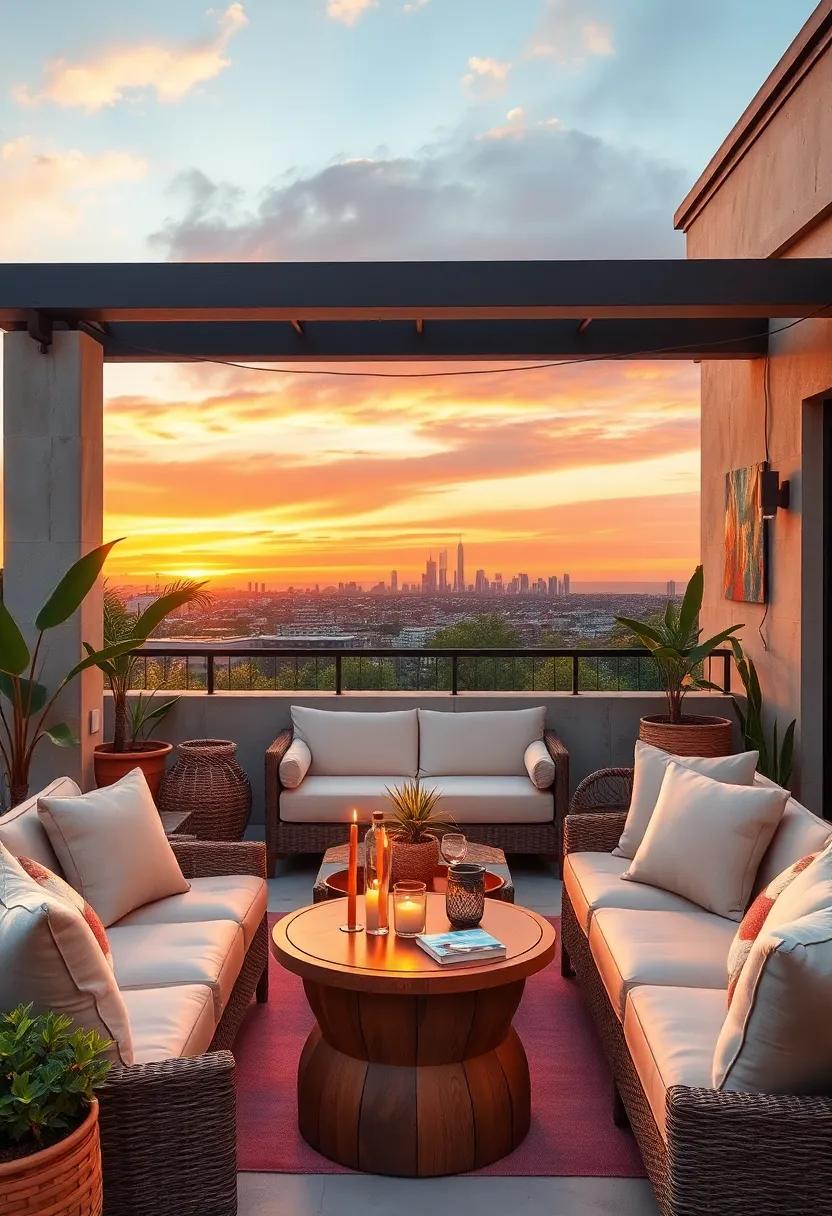
Imagine your outdoor space bathed in the gentle hues of a setting sun or the soft glow of dawn, where art effortlessly echoes nature’s own transitions. Utilizing warm gradient palettes that blend fiery oranges, subtle pinks, and calming purples, these skylines bring a sense of peace and openness to patios and garden walls alike. They do more than decorate-they create an immersive atmosphere, inviting quiet reflection or lively conversation under expansive gradients that stretch beyond the physical limits of your space.
To evoke these tranquil moods with art, consider:
- Layered silhouettes of distant cityscapes or rolling hills that add depth and intrigue
- Flowing brushstrokes that mimic fading sunlight or the first blush of morning light
- Subtle contrasts to highlight architectural or natural details without overpowering the gentle gradient
Whether painted murals or vinyl decals, these designs transform outdoor walls into horizons of calm-perfect for unwinding or entertaining with a backdrop that breathes tranquility into every evening or early morning gathering.
Impressionist Style Outdoor Murals With Soft Brush Strokes and Pastel Colors Offering Artistic Flair
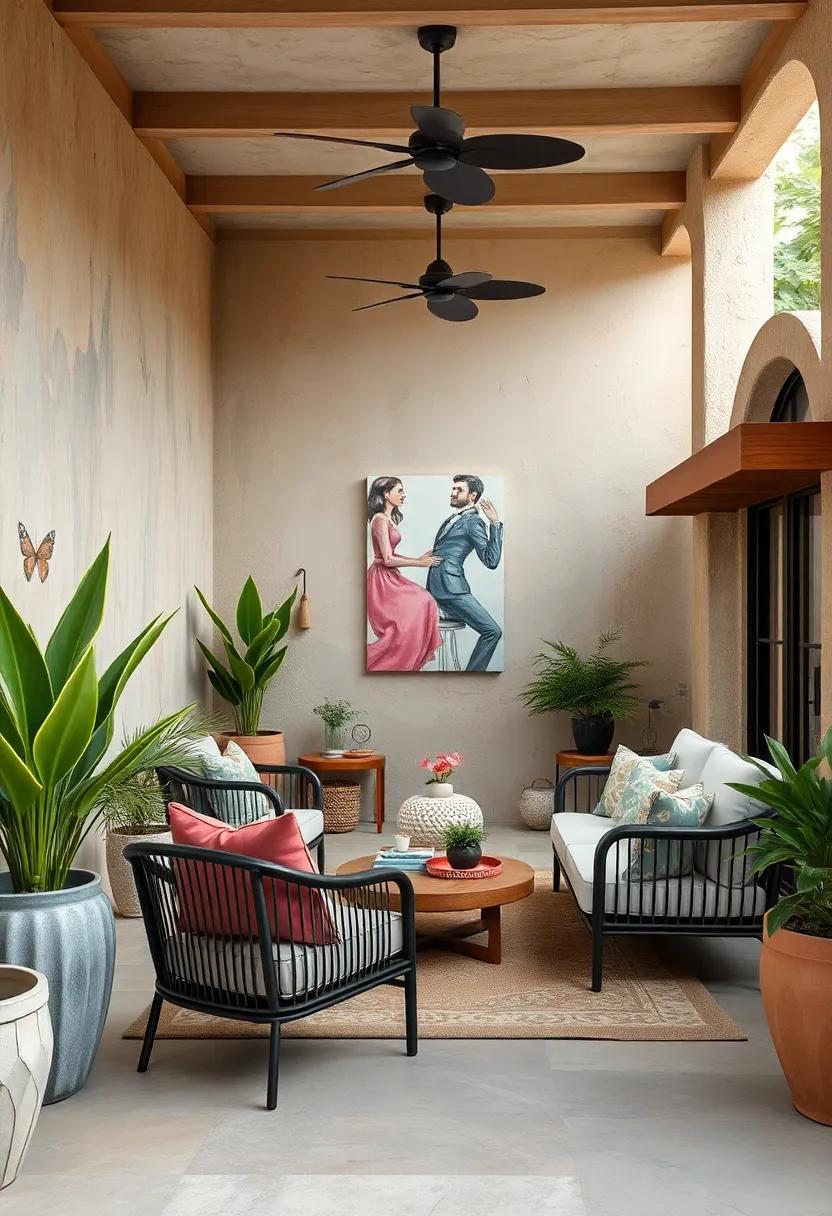
Inject a serene and captivating vibe into your outdoor space by embracing murals that echo the gentle essence of Impressionism. Utilizing soft brush strokes and a palette dominated by pastel hues, these murals create a dreamlike atmosphere that invites relaxation and quiet contemplation. The delicate layering of colors and subtle blending techniques allow the artwork to gently meld with natural surroundings, making your patio an extension of the tranquil beauty found in gardens and open skies.
Choose from a variety of themes to suit your outdoor personality, including:
- Whispering wildflowers swaying in a light breeze
- Fading sunlight over a tranquil water body
- Soft cloudscapes drifting above calm landscapes
- Gentle abstracts inspired by nature’s rhythms
| Brushstroke Style | Color Palette | Mood Evoked |
|---|---|---|
| Feather-light | Soft Pink, Lavender, Mint | Calm & Dreamy |
| Blended Strokes | Pale Blue, Peach, Pale Daffodil | Peaceful & Inviting |
| Soft Dabs | Cream, Soft Green, Blush | Subtle Elegance |
Famous Landmark Silhouettes and Skylines Rendered Creatively for Globetrotting Patio Vibes
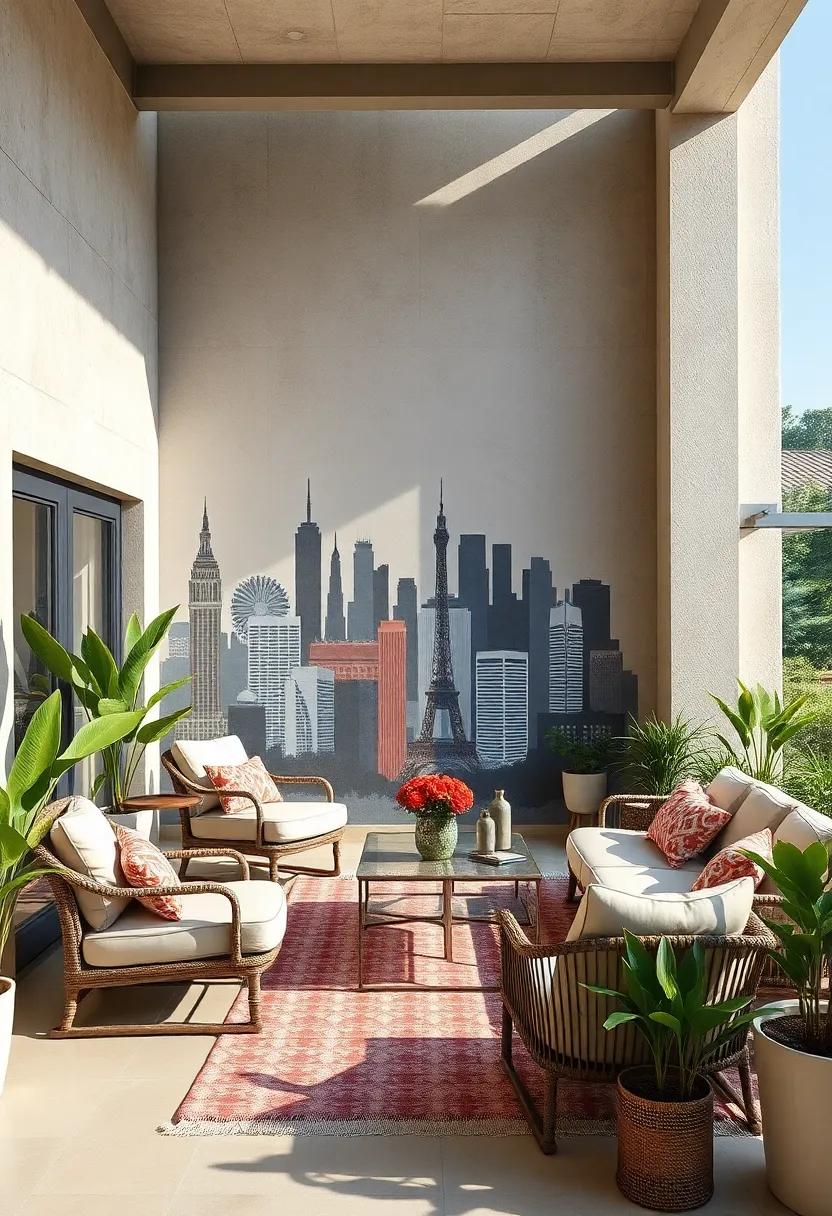
Imagine your patio as a vibrant tapestry of global architecture, where silhouettes of iconic landmarks like the Eiffel Tower, Statue of Liberty, and Sydney Opera House mingle against your outdoor walls. These artistic renditions are more than mere decorations; they invite a sense of wanderlust and evoke the charm of faraway cities right outside your door. With minimalist black or gradient hues, these skylines create a stunning visual effect that transforms plain walls into portals to the world’s most captivating vistas, perfect for intimate gatherings or quiet afternoons basking in cultured ambiance.
To blend style with inspiration, consider incorporating an eclectic mix of elements that complement your chosen landmarks:
- String lights mimicking city lights, draping overhead like a starry skyline.
- Planters and greenery that enhance the mural’s depth, simulating the parks and landscaping typical near urban icons.
- Indoor-outdoor rugs with patterns inspired by the cultural motifs of the featured cities.
| Landmark | Art Style | Color Palette |
|---|---|---|
| Big Ben | Monochrome Silhouette | Black & Slate Gray |
| Tokyo Tower | Vector Gradient | Red, Orange & Yellow |
| Christ the Redeemer | Hand-Painted Mural | Soft Blues & Cream |
Vintage Botanical Prints Featuring Detailed Leaves, Flowers, and Herb Designs for Classic Outdoor Charm
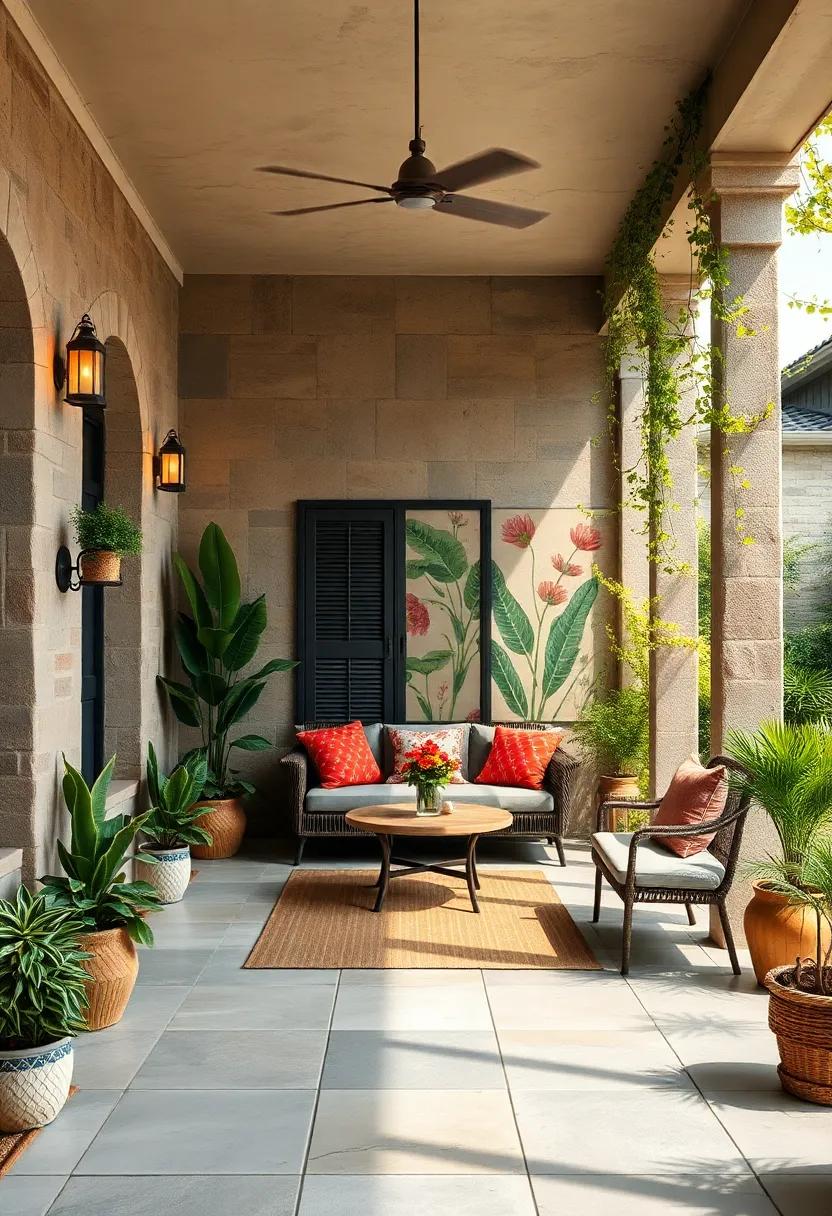
Incorporating vintage botanical prints into your outdoor decor is an effortless way to bring timeless charm and sophistication to your patio. These intricately detailed illustrations, featuring a rich variety of leaves, flowers, and herbs, evoke the delicate artistry of 18th and 19th-century botanical studies. When displayed in rustic wooden frames or distressed metal holders, they create an elegant contrast against natural elements, adding depth and texture to your outdoor space. These prints not only celebrate the beauty of flora but also inspire a connection to nature, enhancing the cozy, serene atmosphere of your garden sanctuary.
To maximize their impact, consider grouping these prints in curated arrangements. Combine various sizes and styles to achieve a layered wall gallery that invites closer inspection and admiration. For a versatile approach, here are some ways to showcase vintage botanical designs effectively:
- Mixed Media Displays: Blend prints with real dried herbs and pressed flowers in shadow boxes for tactile interest.
- Weather-Proof Prints: Use UV-resistant lamination to protect artwork from the elements without sacrificing vintage appeal.
- Herbal Themed Corners: Designate sections of your patio for herb-inspired art paired with fragrant plants like rosemary and lavender.
| Plant Type | Common Use | Visual Appeal |
|---|---|---|
| Lavender | Aromatherapy | Soft purple blooms, graceful stems |
| Fern | Shade-loving plant | Delicate, lacy leaf patterns |
| Mint | Culinary herb | Bright green leaves, refreshing vibe |
Celestial Mural Themes Showcasing Stars, Moons, and Nebulas to Inspire Evening Patio Gatherings
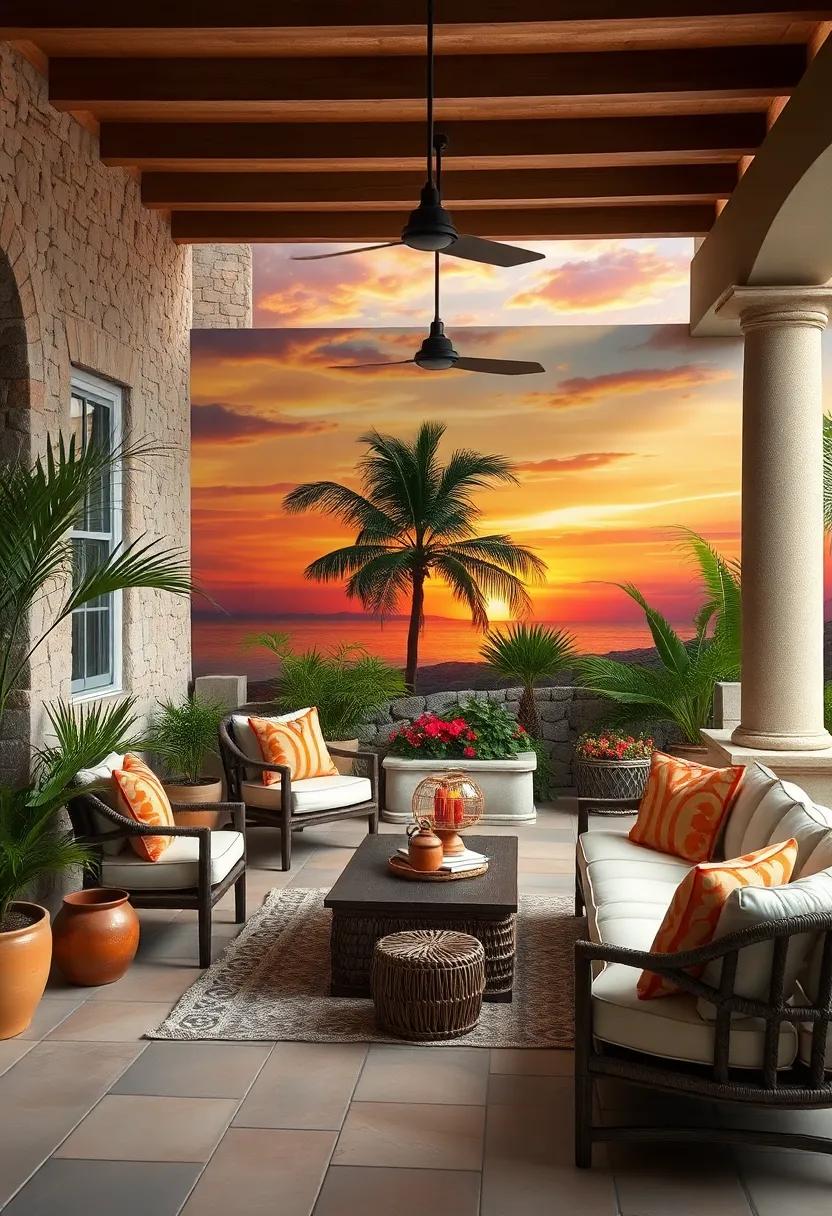
Imagine your patio bathed in the glow of a hand-painted galaxy, where each brushstroke brings the night sky to life with shimmering stars, crescent moons, and swirling nebulas. These murals do more than decorate-they set a magical ambiance perfect for evening gatherings. The interplay of deep midnight blues and radiant silvers creates a serene backdrop, inviting friends and family to unwind beneath an ever-present cosmic canopy. Such art not only transforms a plain wall into a celestial masterpiece but also encourages conversation, inspiration, and a touch of wonder as day melts into night.
When choosing a celestial mural, consider incorporating elements like:
- Twinkling star clusters that sparkle with subtle glitter or LED highlights.
- Moons in various phases to symbolize change and growth.
- Vibrant nebulas painted with gradients of purples, blues, and pinks for depth.
- Constellations that can be personalized to favorite zodiac signs or stories.
These elements can be mixed and matched to craft a truly unique mural that reflects your personal style and enhances the tranquil beauty of your outdoor retreat.
| Design Element | Suggested Color Palette | Effect on Atmosphere |
|---|---|---|
| Stars | Silver, White, Soft Yellow | Creates a twinkling, dynamic feel |
| Moons | Slate Grey, Soft Blue, Ivory | Evokes calmness and mystery |
| Nebulas | Purple, Pink, Blue Gradients | Adds dreamy and ethereal dimension |
Cultural and Ethnic Patterns Celebrating Global Artistic Traditions on Your Outdoor Wall Canvases
Bring the vibrancy of global cultures right to your patio by incorporating artistic traditions from around the world into your outdoor wall designs. Consider murals that showcase intricate Moroccan zellige patterns, with their mesmerizing geometric shapes and rich jewel tones, or perhaps the bold, rhythmic strokes of Aboriginal dot art that tell ancient stories of the land. Such designs don’t just decorate-they invite authenticity and deep cultural resonance, sparking curiosity and conversation among your guests. Complementing these murals with handcrafted textiles, like Mexican talavera-inspired ceramics or Japanese sakura motifs, transforms your space into a living gallery where heritage shines under open skies.
To help you curate the perfect blend of global artistry, here’s a simple guide to some iconic patterns, their regions, and symbolic meanings that add layers of storytelling to your outdoor retreat:
| Pattern | Origin | Symbolism |
|---|---|---|
| Kente Cloth Motifs | Ghana | Wisdom, unity, leadership |
| Navajo Weaving Patterns | Southwestern USA | Harmony with nature, spiritual balance |
| Indian Madhubani Art | India | Fertility, prosperity, protection |
Layering these motifs across mural sections or mixing patterns in curated wall hangings creates a textured narrative that transcends cultures and seasons. Whether embellished with vivid color palettes or subtle earth tones, these global influences breathe life and character into your outdoor space, making each wall a testament to artistry that spans continents.
Animal Motifs and Wildlife Portraits Depicted in Lush Detail for a Naturalistic Backyard Ambiance
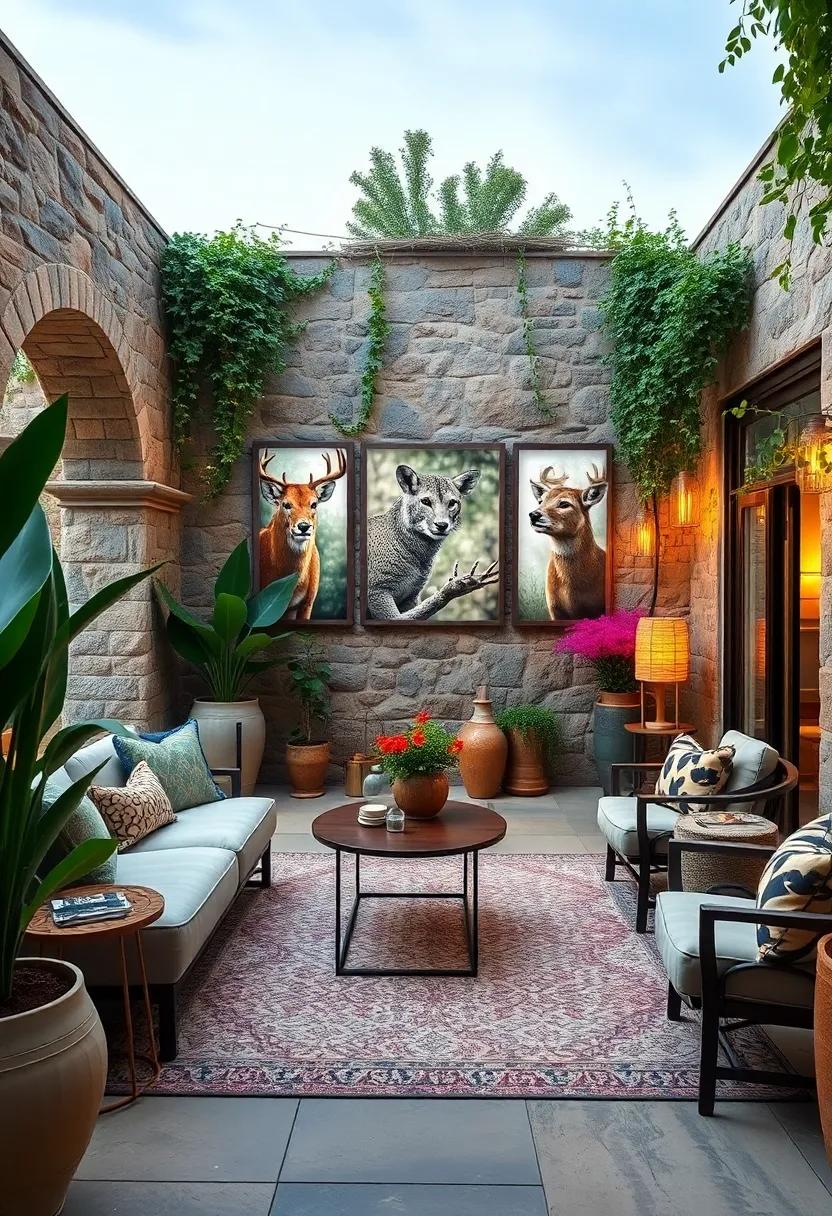
Inject a sense of wilderness into your patio décor by incorporating intricately detailed animal motifs that bring the essence of nature right to your doorstep. Whether you opt for majestic owls perched on tree branches, vivid butterflies fluttering amidst blooming flowers, or serene deer grazing in verdant meadows, these creatures add a dynamic energy that transforms an ordinary space into a sanctuary of life and color. The beauty of such artwork is in the meticulous craftsmanship; every feather, scale, and fur strand is rendered with painstaking care, creating a tactile experience that invites closer examination and a deeper connection to the outdoor environment.
For those aiming for a more immersive wildlife experience, wildlife portraits are an exceptional choice. Large-scale murals featuring animal subjects in their natural habitats can establish an atmosphere that is both relaxing and inspiring. Consider pairing these murals with complementary elements to enhance the theme:
- Earth-toned cushions and rugs to mimic the forest floor
- Natural wood or stone planters housing native plants
- Soft ambient lighting reminiscent of dawn or dusk
| Animal | Symbolism | Recommended Placement |
|---|---|---|
| Fox | Cunning, adaptability | Near seating areas |
| Hummingbird | Joy, energy | Above garden beds |
| Wolf | Strength, family | On focal walls |
This carefully curated approach ensures that the artwork not only captivates but also harmonizes seamlessly with the organic elements around it, enveloping your patio in an authentic naturalistic ambiance.
Rustic Farmhouse Murals Combining Warm Wood Textures and Country-Inspired Illustrations
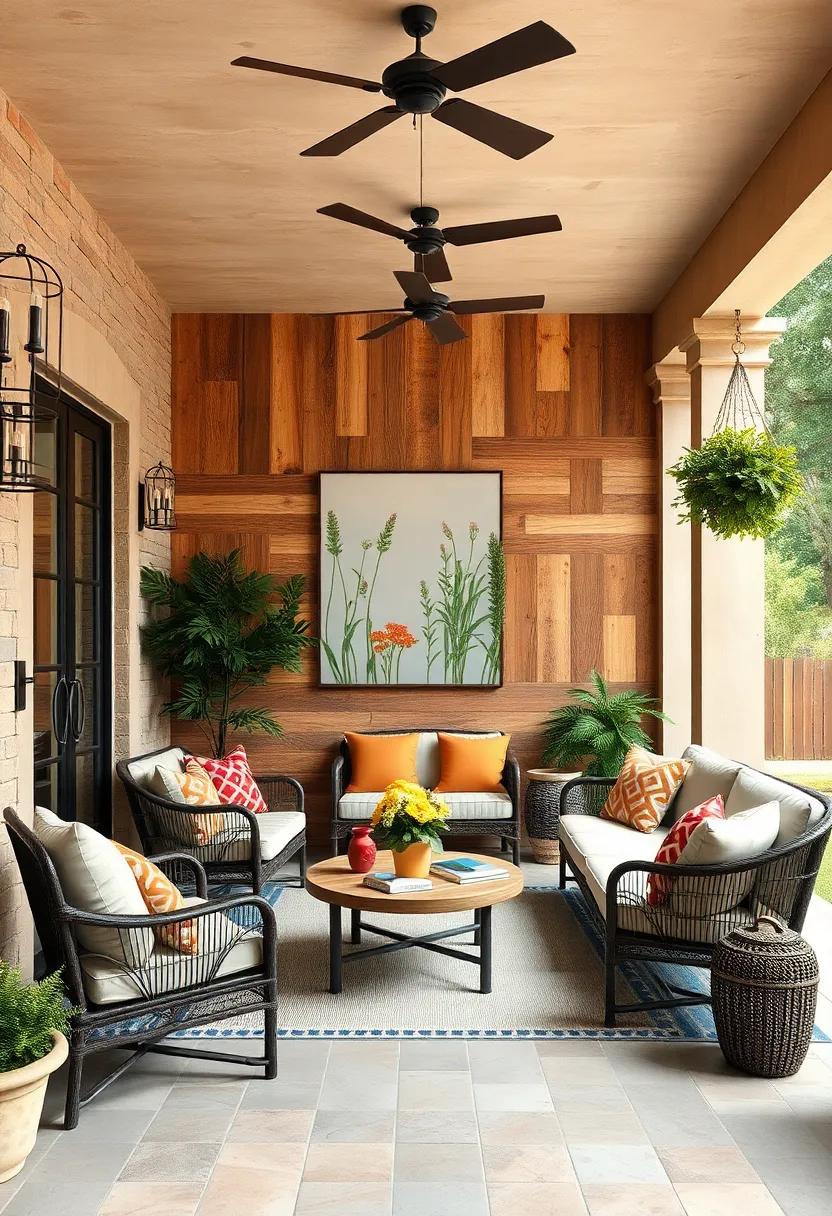
Embracing the charm of rustic aesthetics, these murals bring together the tactile richness of warm wooden textures with whimsical country-inspired illustrations. Imagine a backdrop where sun-kissed barnwood patterns seamlessly merge with hand-painted motifs of blooming wildflowers, vintage farm tools, and playful farm animals. The interplay between natural grains and soft, illustrative strokes not only adds depth but also evokes a sense of nostalgia, making your patio feel like an inviting corner of the countryside.
To capture this authentic farmhouse vibe, consider combining elements such as:
- Distressed wood panels as a mural base for an aged, timeworn effect
- Delicate sketches featuring roosters, sunflowers, and hay bales
- Muted earth tones blended with pops of soft pastels to balance warm and cool hues
| Design Element | Effect on Space |
|---|---|
| Reclaimed Wood Texture | Adds warmth and rustic authenticity |
| Hand-drawn Farm Animals | Injects playfulness and charm |
| Soft Floral Patterns | Creates gentle, inviting ambiance |
Art Deco Inspirations With Bold Symmetry, Rich Colors, and Ornate Details for Luxurious Patio Scenes
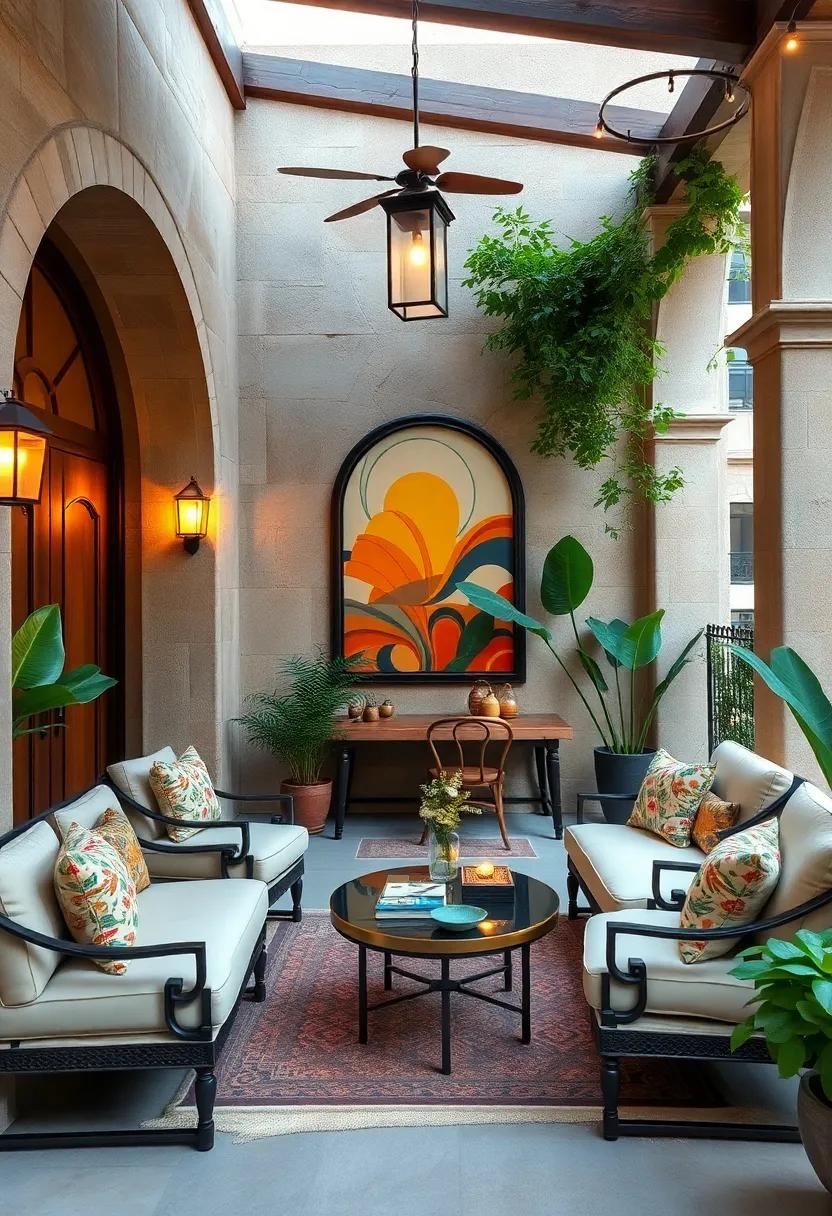
Elevate your outdoor space with dramatic wall art that channels the timeless allure of Art Deco. Think intricate geometric patterns paired with bold symmetry-each mural a statement piece boasting golden accents against rich, jewel-toned backgrounds like emerald, sapphire, and ruby. These visually striking elements not only add depth but cultivate an ambiance of refined elegance perfect for alfresco entertaining. Consider incorporating metallic finishes and mirrored surfaces to amplify the luxe effect, creating a captivating interplay of light and shadow that transforms your patio into an artful sanctuary.
To capture the essence of this opulent style, introduce decorative elements such as:
- Stylized sunbursts and fan motifs as focal points
- Symmetrical borders framing lush tropical or feather patterns
- Rich color palettes blending deep blues with glimmering gold leaf details
- Ornate, layered designs to add texture and dimension
These choices invite a balance of sophistication and vibrancy, making your patio feel like an outdoor gallery where classic glamour meets contemporary taste.
Funky Pop Art Murals Bursting With Bright Colors and Playful Icons to Energize Your Outdoor Space
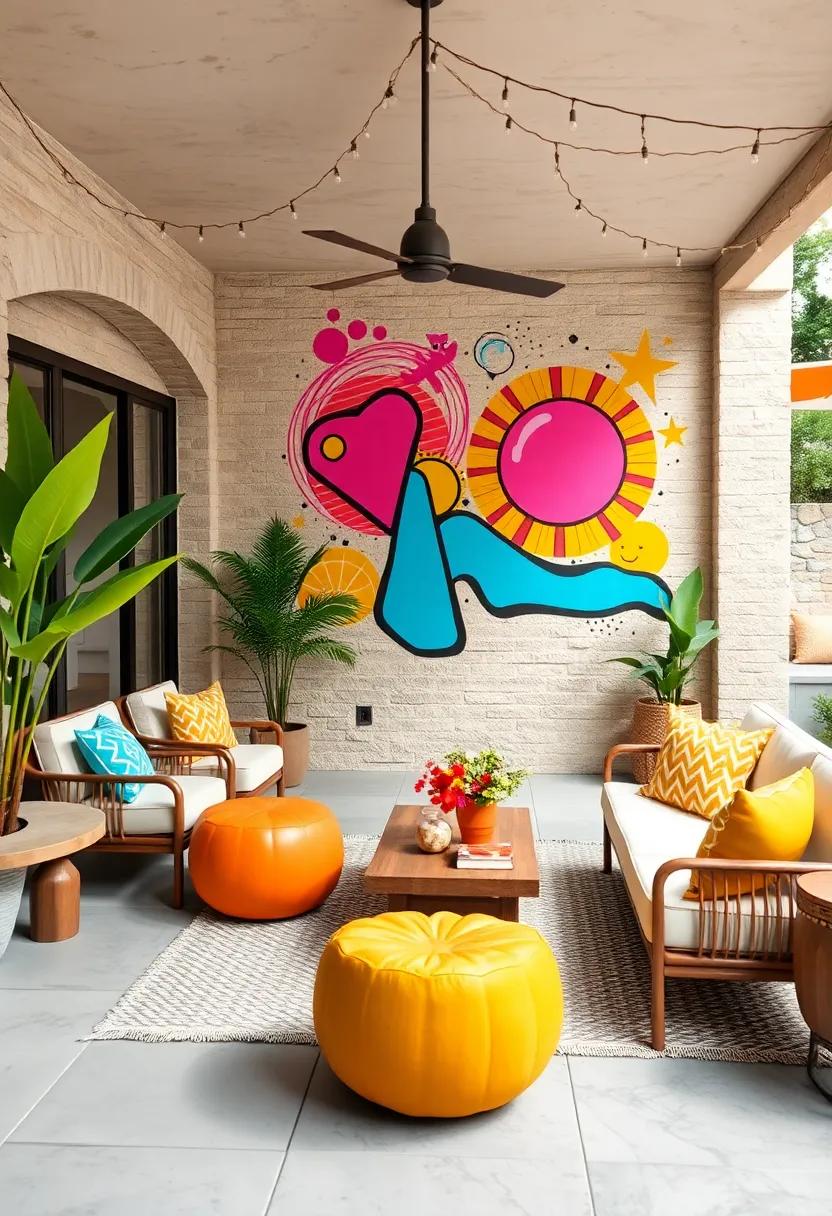
Inject a burst of energy into your outdoor haven with eye-catching murals that celebrate the playful spirit of pop art. These bold creations fuse vivid hues with whimsical icons-think oversized ice cream cones, funky animals donning sunglasses, and dynamic speech bubbles-that instantly uplift any dull wall. The vibrant color palette doesn’t just catch the eye; it breathes personality and fun into your patio, transforming it into a lively visual playground where creativity reigns supreme.
Incorporating these murals is easier than you think, thanks to a variety of styles and techniques suited to any space. Whether you prefer hand-painted masterpieces or weather-resistant vinyl decals, you can customize your wall art to match your vibe. Here’s what makes funky pop art murals a must-have for your outdoor style:
- Bright, bold colors: Spark joy and draw attention with neon shades and rainbow gradients.
- Playful icons: Add quirky characters and retro-inspired motifs that tell a story.
- Dynamic shapes: Geometric forms combined with fluid lines create intriguing contrasts.
- Durability: Use UV-resistant paints or waterproof finishes to keep colors vivid over time.
| Material | Longevity | Ideal For |
|---|---|---|
| Acrylic Paint | 5+ years | Permanent wall art |
| Vinyl Decals | 3-6 years | Seasonal or temporary decor |
| Weatherproof Spray Paint | 4+ years | Outdoor murals with quick application |
Mystical and Mythical Creature Themes Adding Fantasy and Wonder to Your Patio’s Visual Storytelling
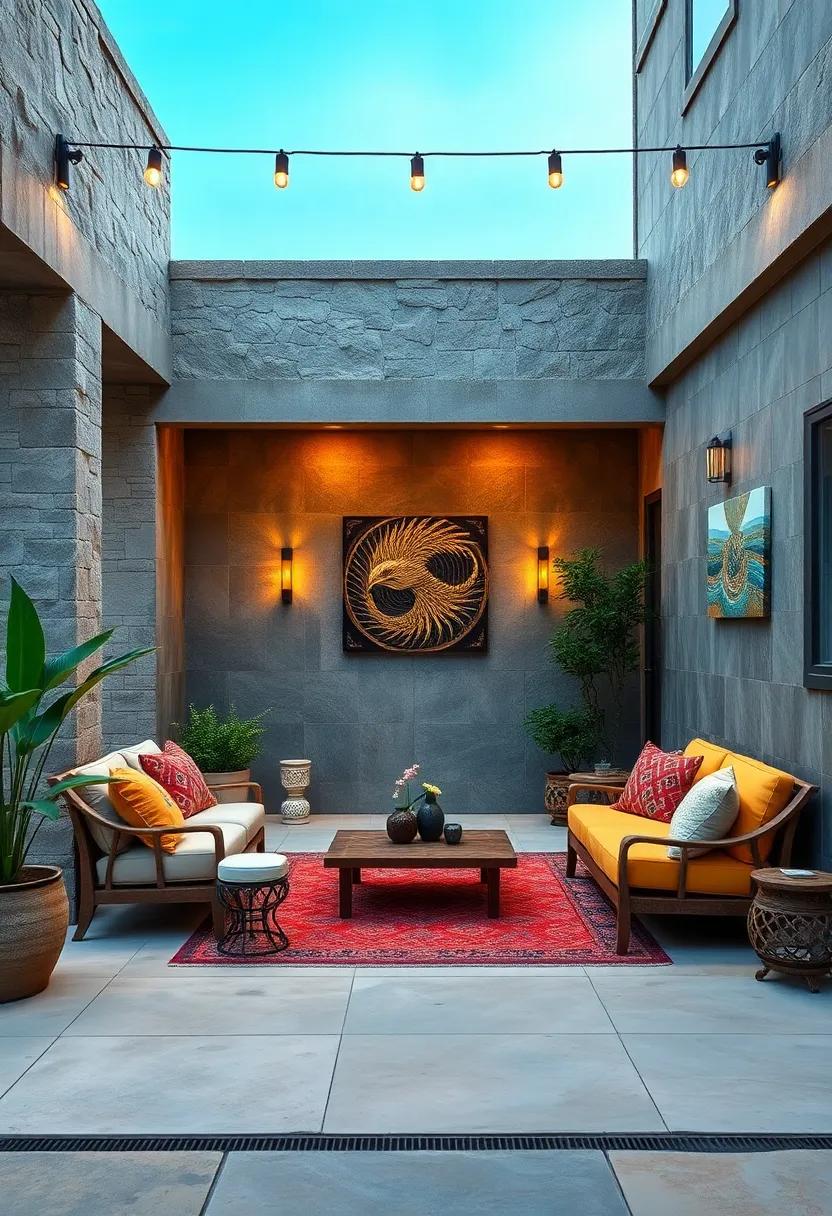
Envision your outdoor sanctuary adorned with enigmatic creatures from ancient legends and timeless fantasies. Incorporating mystic beings like dragons, phoenixes, or whimsical unicorns into your patio’s mural sparks curiosity and conversation, inviting every visitor to step into a world woven from myths and imagination. These artistic narratives add layers of enchantment and depth, transforming blank walls into portals of wonder that seamlessly blend nature’s tranquility with fantastical allure.
To amplify the magical ambiance, consider emphasizing key thematic elements that instantly evoke a sense of the extraordinary:
- Celestial motifs: Stars, moons, and galaxies intertwined with mythical figures.
- Elemental forces: Fire-breathing dragons, water nymphs, and wind spirits enhance natural vibes.
- Nature’s mysticism: Enchanted forests inhabited by faeries and mythical beasts.
| Creature | Symbolism | Color Palette |
|---|---|---|
| Dragon | Strength, protection | Fiery reds, gold, deep emerald |
| Unicorn | Purity, magic | Soft pastels, iridescent hues |
| Phoenix | Rebirth, transformation | Flaming oranges, crimson, gold |
By letting these mystical themes dictate your patio’s artistic direction, you not only create a visually captivating environment but also inspire a sense of adventure and mystery. Every glance becomes a narrative journey, where fantasy weaves through real life, enriching your outdoor space with timeless stories and boundless creativity.
Oceanic Life Depictions Incorporating Coral Reefs, Tropical Fish, and Sea Turtles in Vivid Murals
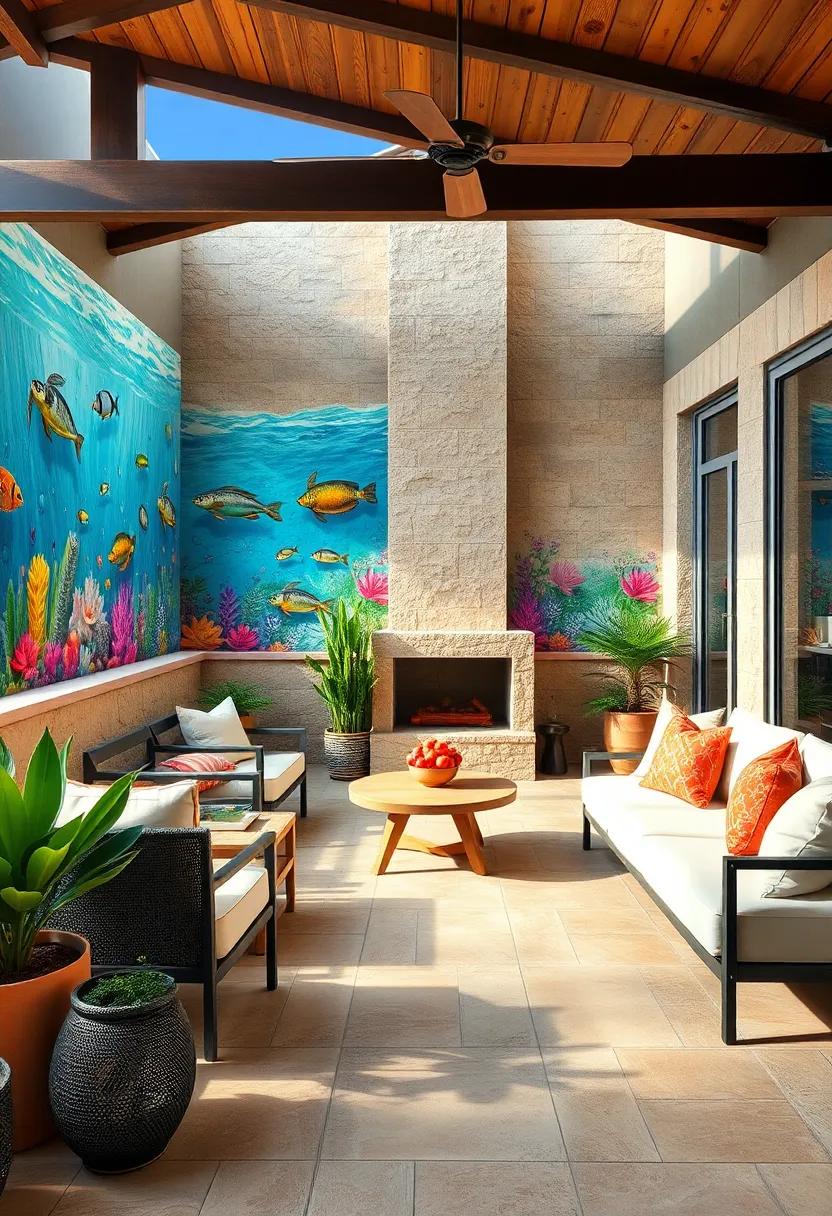
Bring a splash of aquatic wonder to your outdoor sanctuary with wall art that captures the vibrant heartbeat of oceanic life. Imagine coral reefs bursting in brilliant shades of orange, pink, and purple, meticulously detailed to evoke the delicate complexity of their natural counterparts. These murals not only add depth and color but also cultivate a tranquil ambiance reminiscent of a hidden underwater paradise. Sea turtles gracefully glide over the coral bases, their slow, majestic movements frozen in time, while tropical fish weave through swaying anemones, their iridescent scales shimmering against the mural’s expansive backdrop.
Incorporating these elements into your patio design means more than just decoration; it’s an immersive experience that invites relaxation and awe. Consider features such as:
- 3D textured paint: to simulate coral surfaces for an extra tactile dimension.
- UV-resistant colors: ensuring your mural remains vibrant despite sun exposure.
- Integrated lighting: strategically placed LED to mimic underwater sparkle and highlight marine details at dusk.
| Feature | Visual Effect | Emotional Impact |
|---|---|---|
| Colorful Coral | Bright, textured accents | Stimulates curiosity and calm |
| Tropical Fish | Dynamic movement and shimmer | Invokes joy and liveliness |
| Sea Turtles | Graceful, serene figures | Promotes relaxation and reflection |
Soft Watercolor Effect Wall Art Bringing an Ethereal and Dreamy Quality to Your Patio Environment
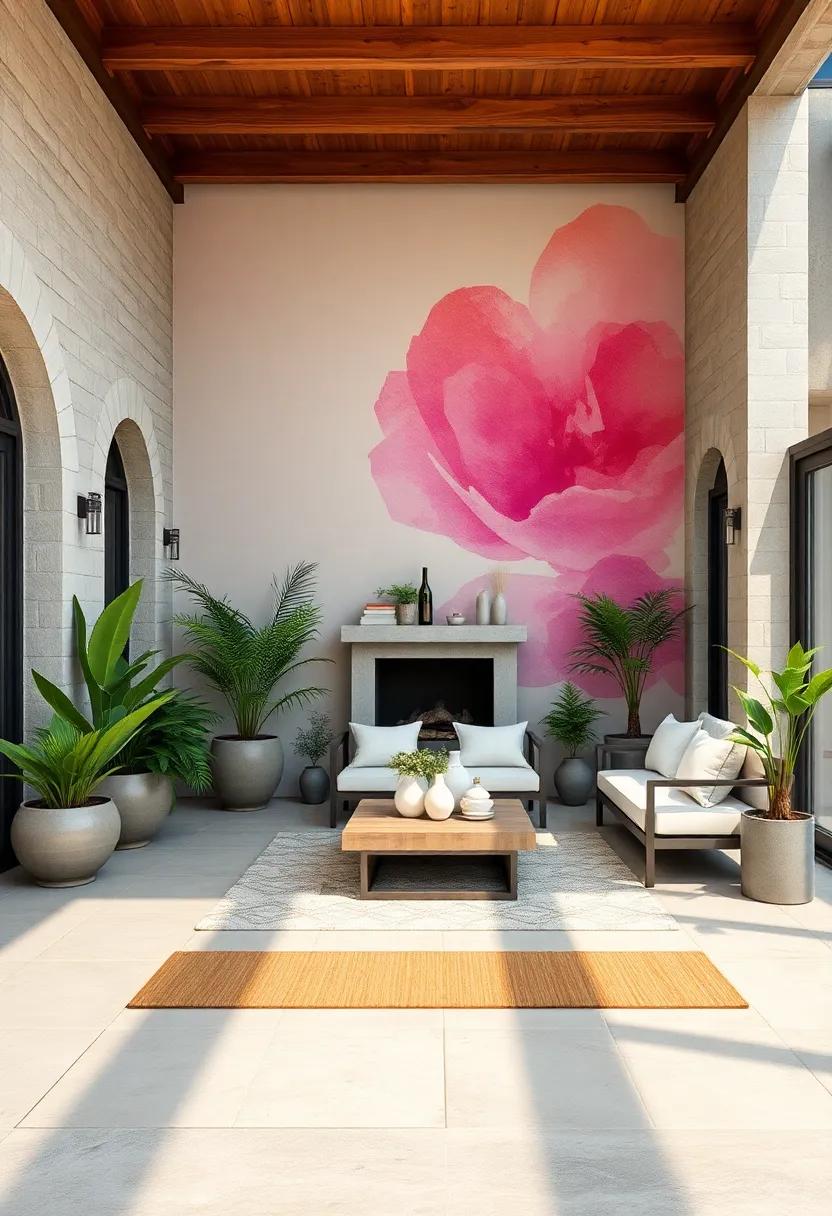
Delicate hues and gentle transitions characterize watercolor-inspired wall art, creating an inviting atmosphere that seems to dissolve the boundary between indoor comfort and outdoor freshness. These pieces breathe life into any patio, infusing the space with a serene, ethereal vibe that feels both organic and artful. The subtle washes of color mimic nature’s own palette at dawn or dusk, offering a tranquil backdrop perfect for relaxing afternoons or intimate evening gatherings.
To evoke this dreamlike quality with your wall decor, consider elements that highlight the fluidity and softness typical of watercolor art:
- Pastel color schemes: Soft pinks, blues, and greens softly blend without harsh edges.
- Layered translucency: Overlapping shapes and gradients that build depth and intrigue.
- Botanical motifs: Ferns, florals, and leafy patterns rendered in gentle brushstrokes.
| Effect | Visual Impression | Best Placement |
|---|---|---|
| Blended Layers | Soft depth with no defined edges | Main patio wall or behind seating area |
| Muted Pastels | Calm & peaceful mood enhancer | Near planters or natural elements |
| Transparent Brush Strokes | Light, airy, and dreamy touch | Accent walls and corners for focal points |
Graffiti Lettering and Typography Murals With Bold Statements and Vibrant Color Splash
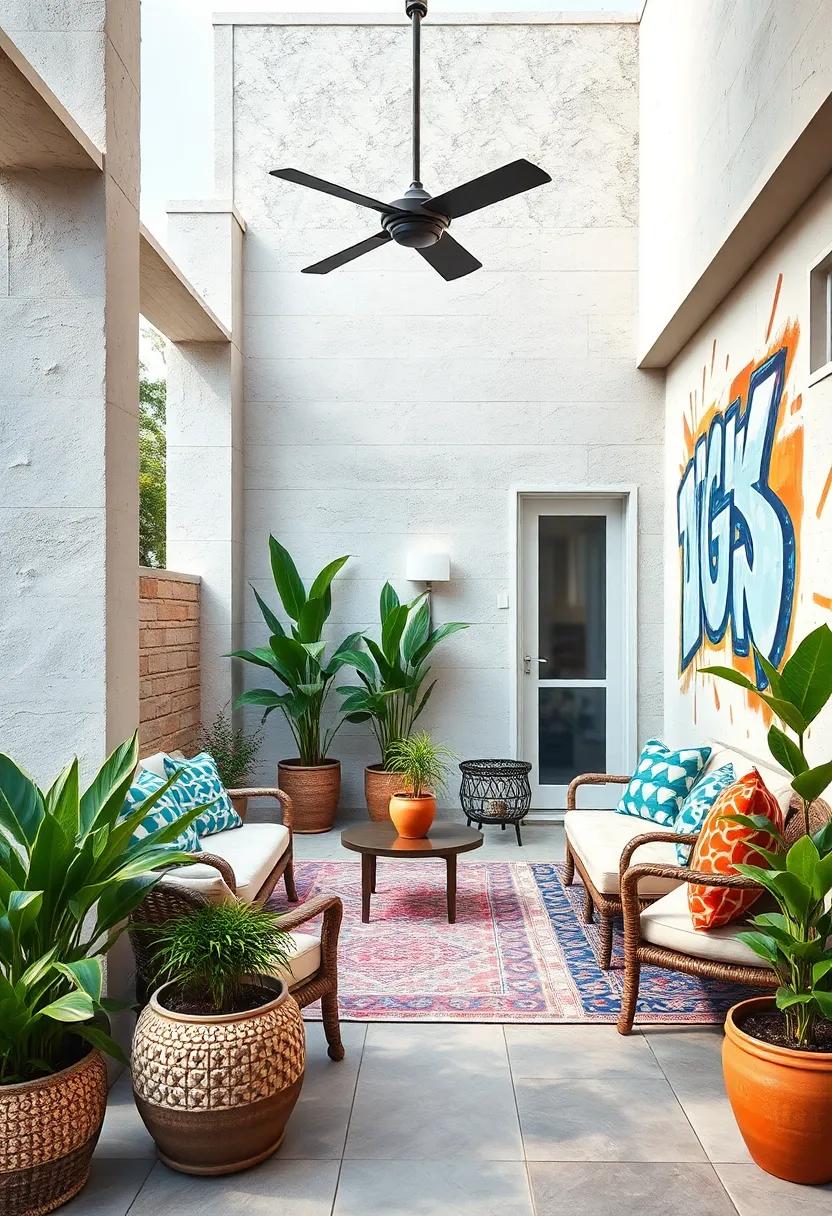
Elevate your outdoor space by introducing graffiti lettering and typography murals that shout personality and flair. These murals fuse artistic fonts with expressive words, creating an atmosphere that sparks conversation and ignites inspiration. Imagine bold slogans, heartfelt quotes, or even playful phrases that reflect your vibe-each stroke layered with vivid, eye-catching colors that splash across your patio wall like a radiant sunset. The interplay of sharp angles and fluid curves in the lettering gives the space depth and motion, making your patio not just a place to relax but a living canvas of self-expression.
When planning your design, consider mixing these elements for a dynamic visual impact:
- Contrasting Color Palettes: Pair bright neons with deep shadows to make text pop.
- Textured Brush Strokes: Add layers of dimension and tactile appeal to letters.
- Personalized Messages: Bring individuality with custom phrases that resonate.
| Design Element | Effect | Best Use |
|---|---|---|
| Bold Sans-Serif Fonts | Strong, modern appeal | Headline phrases or names |
| Vibrant Watercolor Blends | Dynamic, fluid motion | Backgrounds or accents |
| 3D Lettering Shadows | Depth and realism | Catch attention on focal points |
Sun-Kissed Tropical Sunset Murals Embracing Warm Hues and Palms for a Relaxed Outdoor Feel
Imagine stepping into your backyard and feeling instantly transported to a serene tropical paradise. Warm hues of tangerine, coral, and golden amber wash over the walls, capturing the essence of a sun-drenched sunset. These vibrant, sun-kissed tones seamlessly blend with intricate palm silhouettes, inviting relaxation and a gentle breeze into your outdoor space. Whether painted by hand or applied as wallpaper murals, this artistic vision breathes life into bare patios and decks, creating an inviting atmosphere that encourages unwinding and soaking in the evening glow.
To elevate this ambiance, consider complementing your mural with natural textures and accessories. Here’s a quick guide to styling your tropical sunset oasis:
- Woven rattan furniture: Adds earthiness and tactile comfort
- Soft linen cushions: Reflects calming, beach-inspired tones
- Ambient string lights: Enhances the glow as daylight fades
- Terracotta or ceramic planters: Tie the mural’s warm colors to living greenery
| Element | Effect | Styling Tip |
|---|---|---|
| Warm Hues | Creates cozy, inviting warmth | Pair with neutral tones for balance |
| Palm Silhouettes | Evokes tropical calm and natural beauty | Use repeated patterns for visual flow |
| Ambient Lighting | Softens the space as sun sets | Choose dimmable, warm bulbs |
Black and White Contrast Murals Using Bold Shadow Play for Striking Artistic Expression Outdoors
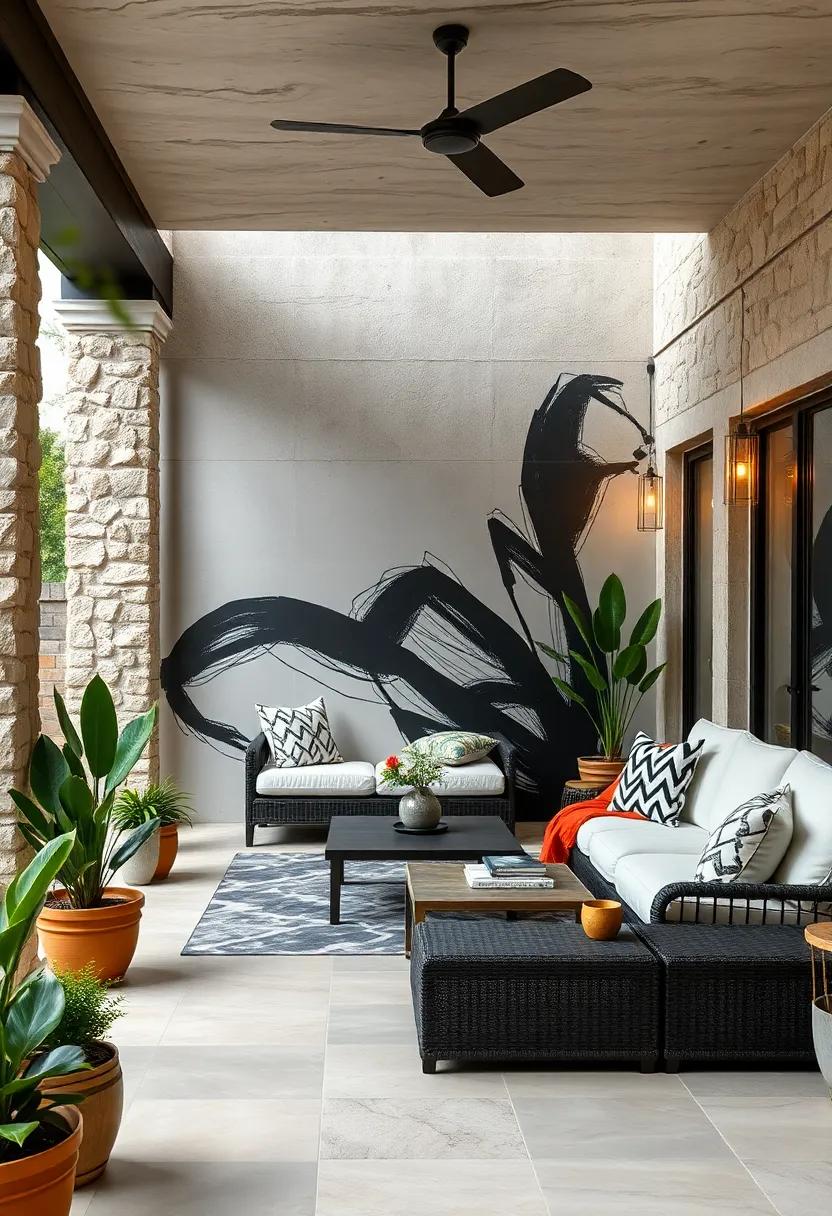
Bold shadow play in monochrome murals brings a dynamic edge to any outdoor space, creating a visual dialogue between light and darkness that captivates onlookers. These black and white contrasts introduce a timeless sophistication, turning plain walls into stunning canvases of depth and movement. Whether it’s abstract shapes or sharply defined silhouettes, the interplay of shadows intensifies the mural’s narrative, inviting viewers to linger and interpret the bold forms. This style thrives in natural light, emphasizing every contour and angle, making your patio not just an outdoor area but an experiential art gallery.
To effectively incorporate this style, consider these design elements:
- Strong light source: Position murals where sunlight creates natural shadows for added drama.
- Geometric precision: Sharp edges and contrasting shapes maximize impact and clarity.
- Minimalist color palette: Exclusively black, white, and shades of gray streamline focus and enhance contrast.
- Texture variation: Experiment with smooth and rough wall surfaces to diversify shadow effects.
| Element | Impact on Visual Appeal | Outdoor Consideration |
|---|---|---|
| Bold Shadows | Creates depth and intrigue | Varies with daily light changes |
| Black & White Palette | Ensures timeless style | Fades less visibly in sunlight |
| Sharp Lines | Defines forms clearly | Requires precise application |
| Texture Play | Adds tactile interest | Enhances natural weathering effects |
Contemporary Cubism Inspired Murals Featuring Fragmented Perspectives and Dynamic Shapes
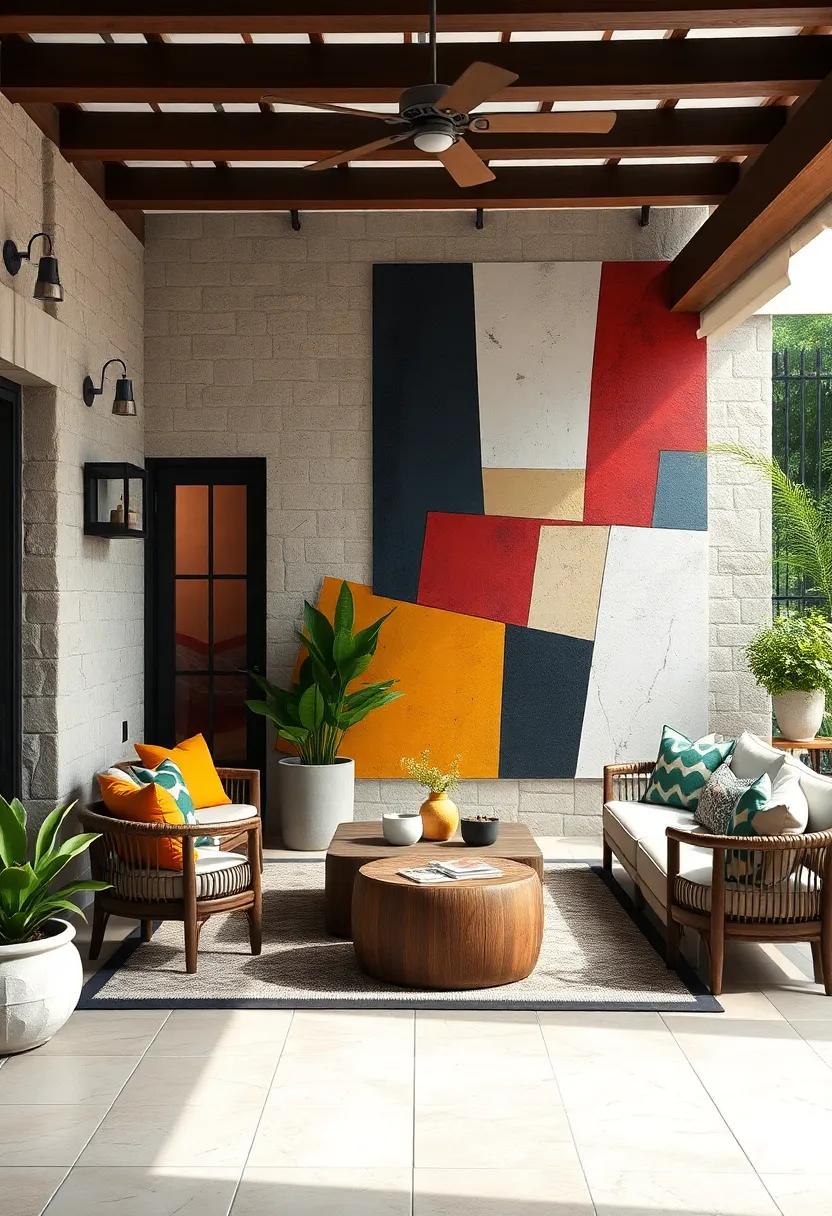
Embracing the avant-garde spirit of contemporary cubism, these murals transform ordinary patio walls into vibrant narratives of fragmented realities. Bold geometric shapes collide and dance across surfaces, challenging the eye to piece together a visual puzzle imbued with energy and movement. The interplay of overlapping planes and shattered perspectives not only captures attention but also encourages visitors to engage more deeply with the artwork, creating a dynamic ambiance that elevates outdoor living spaces to new artistic heights.
Key elements of this style include:
- Asymmetric Composition: Dynamic arrangements break the traditional balance for a fresh, energetic feel.
- Multi-dimensional Views: Objects and forms are depicted from multiple angles simultaneously, inviting exploration.
- Vibrant Color Blocking: Bold hues intersect with muted tones to enhance depth and contrast.
- Textural Variations: The use of layering techniques adds tactile intrigue and visual complexity.
| Shape | Effect | Color Palette |
|---|---|---|
| Sharp Triangles | Creates tension and energy | Fiery reds, oranges |
| Overlapping Squares | Suggests layering and dimension | Blues, grays |
| Curved Fragments | Softens edges, adds flow | Soft pastels, greens |
Mural Gardens Showcasing Flowers Blooming Off The Walls With Realistic 3D Visual Effects
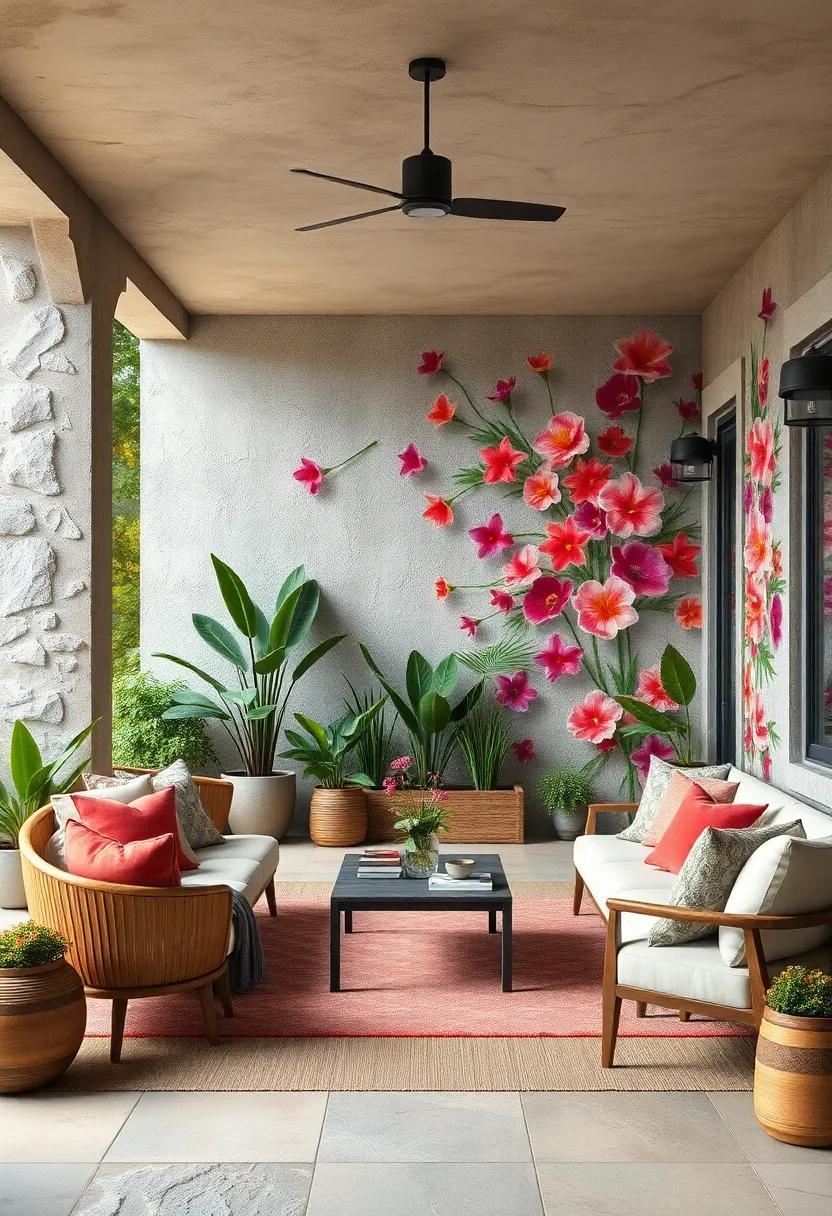
Imagine stepping into your backyard, where vibrant blooms seem to burst from the walls themselves, crafting an immersive garden experience that transcends traditional outdoor decor. These murals aren’t just painted pictures; they are masterpieces of illusion that invite the eye to wander beyond flat surfaces. By incorporating shadows, layered textures, and delicate brush strokes, artists create a palpable depth, making flowers, vines, and leaves appear as if they’re reaching out to the viewer. This technique transforms any ordinary patio wall into a dynamic celebration of nature’s beauty, engaging all senses and inviting you to linger in a space alive with color and movement.
To achieve the most striking realism, consider these elements when planning your own mural garden:
- Textural variety: Use raised paint or mixed media to add tactile dimension so petals and foliage can practically be felt.
- Light and shadow play: Mimic natural lighting for flowers to emphasize 3D effects and seasonal changes.
- Color gradients: Transition hues smoothly to give layers depth and bring the blooms to life.
| Design Element | Effect |
|---|---|
| Raised Paint | Creates tactile realism |
| Soft Shadows | Enhances depth perception |
| Gradient Colors | Simulates natural light |
In Summary
As your outdoor space becomes an extension of your personal style, the possibilities for creative wall art and murals are truly endless. Whether you choose bold geometric patterns, nature-inspired motifs, or personalized designs, these artistic touches breathe new life into your patio, turning it into a captivating retreat. Embrace the transformative power of art to elevate your outdoor ambiance-because your patio deserves to be as vibrant and inviting as the moments you share there.

